 By Pepper Parr By Pepper Parr
January 22, 2016
BURLINGTON, ON
It’s called being between a rock and a hard place, The rules will ‘get ya’ every time.
Your city council and the staff at city hall will say, whenever they get the chance, that they are always transparent and always accountable and that they are there to serve the people of the city.
The words “citizen engagement” are sprinkled throughout the Strategic Plan that is working its way through the bureaucracy.
Look at this situation and see if you can find the transparency or the accountability or even a smidgen of citizen engagement.
 Director of Finance Joan Ford does a great job of providing the data. Burlington has a very good finance department; some of the most diligent people on the city payroll work in that department. They usually always have their fingers on whatever number a member of council might want. Whenever Treasurer Joan Ford doesn’t have a number at her finger tips or makes a small mistake she actually blushes with embarrassment and correct the error very quickly.
Our only beef is that the finance people are not particularly interested in engaging the citizens of the city – they are interested, and are very good at informing the public. These are two different approaches to civic government.
But that is not the current issue. The finance people set an aggressive agenda to get the 2016 budget completed. Debates on the budget take place within a Standing Committee.
Staff set out several days for the process of budget delegations and debate to take place.
Tuesday, January 19th: 10:30 to 6:30 – the meeting ended just after 4:30 pm
Wednesday January 20th: 10:00 am to 4:00 pm.
Thursday January 21st: 3:00 pm to 5:30 pm. This meeting did not take place; the Standing Committee was able to adjourn at 4:00 on the Wednesday when they set they recommended a tax increase of 3.16%
Delegations were held on the Tuesday during the day. For some reason they saw no reason to hold evening sessions- why not?
Why wasn’t there more in the way of public notices – the Gazette would have cheerfully run an advertisement for the city had they chosen to use our medium – which gives better value than any other media in the city – but I digress.
The delegations were strong, factual and well delivered and members of council certainly engaged those who were on hand to speak.
The Council debate took place the following day – the Gazette and the Spectator were the only media present.
It was a good debate – we saw some staff behave in a very disrespectful manner when a member of council put forward some data that was supplied by Oakville on their Free Monday for seniors program. A city Director came very close to saying he didn’t believe the numbers read out to him from the Oakville Director of transit. Our city manager, a former Canadian Armed Forces Captain, knows what insubordination is, quite why he didn’t intercede is a question he might want to answer.
When it came to a vote – those wanting the Free Monday transit for seniors lost on a 4 against – 3 for vote.
Councillor Craven is reported to have told an Aldershot resident that he liked the program – but he did not vote for it – that may have been because almost anything Councillor Meed Ward puts forward, Craven opposes. He didn’t speak at any length on the matter during the debate.
 Councillor Paul Sharman voted no – he wanted more data. Councillor Sharman always wants more data before he makes a decision – there does come a point when a decision has to be made based on experience and wisdom. There was the sense that the asking for additional data was punting the ball off the field.
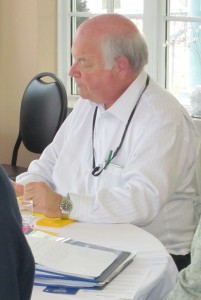 Councillor John Taylor – he voted no – saw free transit as social welfare which most people didn’t need. Councillor Taylor couldn’t help but see Free transit as some form of social welfare; his mind is still stuck in that old style thinking.
One wonders why Taylor does not label the $225,000 that is forgone in terms of parking fees for the free parking members of staff get every year. With that kind of money the city could make the transit service free to everyone.
Votes can be changed at city council; members can change their mind when they have new information.
But here is the rub. If council votes a second time on the budget matter of free transit for seniors on Monday’s and the vote is lost a second time – it cannot be brought back to council again for the balance of the term of office of this council – two and half years, unless the motion is brought by one of the people who originally voted against the motion – and that vote must pass with a 5-2 for vote just to get it on the table.
That is a high hill to have to climb and would make anyone who wanted to attempt to have the vote over turned at council think twice. Forcing the vote kills the opportunity for the balance of this term of office – which we suspect is exactly what some of the Councillors wanted.
A wiser mind would get into discussions with any member of Council they thought could be swayed – and if the votes were not there – then go to ground and wait for the right opportunity.
There is nothing to prevent council from asking the transit people to prepare the document that would set out what the metrics would be to measure a successful pilot program.
At one point Director of Transit said he could have the document done in a day – when pressed a bit he said he would need a couple of weeks.
 Transit Director Mike Spicer, in the yellow shirt, shows Mayor Goldring what he wants in the way of new buses. The pilot program wasn’t due to start until April – so Mike Spicer, the Director of Transit has all kind of time to prepare a report – he might use some of that time to meet with his peer in Oakville and learn just how they made their program work.
There is a sliver of hope for the program. Mayor Goldring suggested that the transit people might want to use the pilot project as a marketing initiative – their response to that was they already had a number of marketing programs.
And how well are they working ? is a question the Mayor might have reasonably asked.
Rick Goldring doesn’t yet fully understand what it is to be a Mayor – as the Chief Magistrate he has a “bully pulpit” which he hasn’t learned to use. He could have and should have asked the Director of Transit to re-think his response and then invite the City Manager and the Director in for a cup of coffee and a chat.
 Mayor Rick Goldring on one of the few occasions that he wore his chain of office during an interview. During the debate James Ridge, City Manager, wouldn’t touch the question. He said – and he right – “this is a political decision.”
That chain of Office the Mayor wears isn’t just a piece of bling. It is a symbol of the office he holds and the authority given him.
There was an opportunity to do something bold, something visionary and, in the words of Jim Young, a chance to show Burlington as a caring, conscientious community.

By Pepper Parr
January 22, 2016
BURLINGTON, ON
A funeral at a Performing Arts Centre? Well first it wasn’t a funeral – it was a celebration of the life of Thomas Sutherland – everyone in the theatre knew him as Tom.
It wasn’t a sold out event but it was better than many of the events for which tickets are sold.
A good 450+ were in their seats to listen to people who loved Tom dearly and wanted to talk about him before his passing in a very sudden death that no one was ready for begins to be forgotten.
His children Kirsten, Derrick and Matthew were there as were his grandchildren: Noel, Gavin, Oland and Jamie.
Walter Mulkewich asked the audience to “grieve the loss of a good man”.
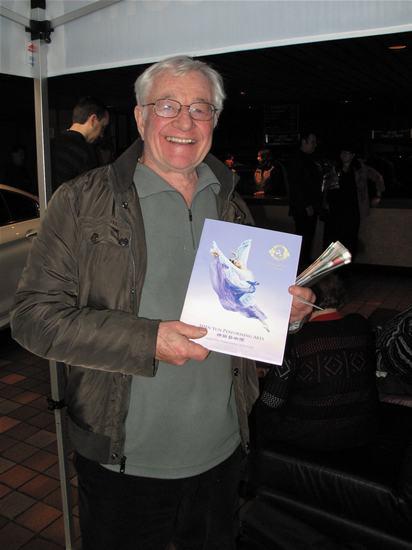 The arts were a big part of Tom’s life – he was an active supporter of the Performing Arts Centre and what was the Burlington Cultural Centre when he first got involved. I didn’t know Tom all that well – we would cross paths – we were both big L liberals and believed in the cause.
I last saw Tom at the Liberal Christmas Party at the Polish Hall. He was his usual loquacious self. I sort of knew he sang but wasn’t fully aware of the roll music played in his life.
That evening he sang and had MPP Eleanor McMahon joining her voice with his. I thought at the time – we are going to hear more of these two. McMahon likes to ham it up and, if one was to believe all that was said at the celebration of Tom’s life this afternoon – Tom was a born arm twister, could sell ice cubes to Eskimos and encyclopedia’s to people who didn’t know they really needed a set of the books until Tom got in front of them.
He sold the Spectator on the corner of King and James in Hamilton when he was a couple of sizes above a sprout – and as his sister told that story you could almost hear him calling out: Extra, Extra – real all about it in the Spectator. There was a time when that was the way newspapers were sold.
Tom did it all –and he did it his way. He loved to take the Frank Sinatra songs and sing his heart out. During the video that was played on Tom with all kinds of pictures there was his voice. I found myself asking if that was Tom or Frank himself.
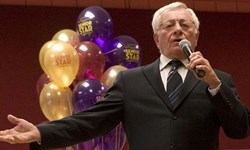 Was he singing or was he giving a speech? For Tom Sutherland they were one in the same – he did prefer the singing. The remarks made by the several people who spoke were more political than I expected and were, I suspect, a significant change for Burlington. The Liberals have only held the two seats for just over a year.
Tom ran federally again Bill Kempling in 1978 and again in 1980; he was the kind of guy who couldn’t pass up on an election campaign. Both MPP McMahon and MP Gould spoke entertainingly about their door to door experiences with the man.
One of the highlights of Tom’s personal political career was the occasion he got to introduce then Prime Minister Pierre Trudeau
He was clearly loved and treasured – he was a one of 11 children – with five of his brothers passing before him.
His sister Loretta spoke of the occasions when the family would be at the pier on the Beach in Burlington – no not the one we paid $14 million for – one of the wooden structures that were a part of the city we have forgotten about. But the Sutherland family hasn’t forgotten those days.
For a family of 11 – it was as if they were a small tribe – they cared for each other; the love was the glue that kept them all together; it was so evident in the pictures that were shown on the screen at the Performing Arts Centre on a Friday afternoon when several hundred people paused in their busy day to Thomas Sutherland.

 By Jim Young By Jim Young
January 21st, 2016
BURLINGTON, ON
I am speaking as a private citizen in support of Burlington Seniors Advisory Committee’s effort to reduce or eliminate Transit Fares for Burlington Senior Citizens. A proposal has been made that City Council and Burlington Transit consider Reduced Transit Fares for Seniors.
In support of, and in addition to the well-made case presented by Mr. Lovell on behalf of Burlington Seniors Advisory Committee, I would respectfully submit to Council and the Budget Committee that Seniors Transit is not just a senior’s issue but is one that affects the entire city, its residents and its reputation as a caring, conscientious community. An issue, which, if addressed effectively, will have beneficial impacts on Traffic Congestion, Road Safety, The Environment and will dovetail perfectly with many aspects of Burlington’s Strategic Plan Proposals currently under review.
As Burlington’s senior’s population approaches 30,000 and continues to grow, it is fair to say our impact on every facet of our city’s way of life is and will continue to be significant.
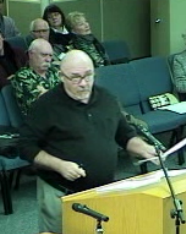 Jim Young Seniors Impact on Burlington’s Traffic Congestion:
There is universal agreement that traffic congestion is becoming a more serious issue in Burlington every year. As council strives to encourage continued growth and increasing population to ensure the economic well-being of our city this congestion will only become more troublesome and the economic and the environmental impact more acute. City Council recognizes this and addresses the issue in its Proposed New Strategic Plan (A City That Moves).
Seniors using affordable transit for one in five of their journeys would reduce traffic congestion by approximately 3%. While that may not sound like much, traffic flow science suggests such a reduction has a major impact on traffic flow and reduced commute times particularly at peak volumes. The more attractive any incentive to switch seniors from cars to transit, the greater that improvement will be. More seniors on transit allows working people, business transport and goods to move more efficiently, improving productivity, and supporting the vibrant business environment our city strives to encourage in that Strategic Plan.
Road Safety:
Studies indicate that as we age our cognitive abilities and response times deteriorate resulting in higher levels of traffic accidents, injuries and claims for senior drivers. The safety of senior drivers and their impact on accident rates is an emotionally charged subject we are loath to address for fear offending spouses, parents or potential voters.
Reduced transit costs for seniors would alleviate that burden by providing a dignified and affordable alternative to driving; thereby reducing the risks with all the human and monetary costs involved for their families, the city, traffic authorities and emergency services.
Reducing traffic accidents by moving seniors from automobiles to transit would also go a long way to meeting the city’s Age Friendly City and a Safe Place to Live objectives of its Proposed New Strategic Plan.
 Jim Young The Environment:
Thirty Thousand Burlington Seniors driving an average of 15,000 Kilometers per year, even allowing for some spousal car sharing, emit 105,000 tons of CO2 into the atmosphere. Every car taken off the road by affordable transit for seniors reduces this annual amount by 3.5 tons.
Again, the Proposed New Strategic Plan aims to make Burlington a Greener Place to Live: an admirable objective for our city that we can help achieve by switching seniors from automobiles to transit and reducing our carbon footprint.
Jim Young has lived in Burlington for more than 30 years where he raised his family and involved himself in his community. He still has a pleasantly strong brogue accent. This opinion pice is a delegation he made during the budget deliberations at city hall.

TO:  Burlington Community and Corporate Standing Committee Burlington Community and Corporate Standing Committee
FROM: Tom Muir
Subject: City Budget 2016
Tom Muir wasn’t able to get to the Standing committee and his schedule didn’t allow him to get to the one public meeting held to “inform” the public abouit the contents of the Operating budget. So he took to the media that is open to every opinion out there and sent the following to the Clerk of the Standing committee to have his comments put on the record. Council tends not to listen to Tom Muir.
Councillors;
Since residents did not enjoy city public engagement on the budget, but have just been informed of spending and taxing plans, I have had to spend significant time finding a focus of my concerns.
It’s far to much to cover all the details, however, the big picture over the 20 year forecast is of particular note and concern to me.
1. The compounded average tax rate increases will double the tax take before the forecast period of 20 years is elapsed. Use the rule of 72 to figure that out. The average tax rate increase over the entire period is 3.62% and this leads to the doubling over 20 years.
Using the example bungalow residence in the budget document, the city tax take will go from $1415 to $2854.
If the other tiers of the total tax burden go up as well, the total tax bill could go from $3410 to $6878.
I have to ask you to ask what residents and businessmen think about that exponential curve trend upwards of this tax burden?
Can business double the price for goods and services over the same time period?
I hope your net income is increasing by more than 4% a year for the next 20. Mine is not.
Is this really raising taxes in an affordable manner?
This is really inflationary, in fact, and is shifting income from residents and business to the city for them to spend.
It seems like Council isn’t really thinking about this cumulative trend, in and of itself, and the consequences, at all.
No comment or request in the budget papers that I saw.
And residents were not asked what they thought, they were not “engaged”, just “informed” – this is what we are doing and here’s the tax take.
I would like to see Council pay a lot of attention to this trend. We need Council to tell the Managers to find the cuts needed to shave this to the inflation rate. And don’t tell me there’s no fat to be found.
Tell them a doubling of city taxes over the next 20 years is not to be tolerated.
2. Regarding the 2015 surplus reported, this $4.75 million is 3.23% of the net tax levy of almost $147 million. Taking $3 million of this and subtracting it from the tax levy, would bring the increase down to about the 2% inflation the city claims.
From the of view of the residents and business people, adding all of this to reserves is akin to adding more fat to the city finances. We don’t need fat there, as the reserves look fat as they are.
I see no explanation of some disaster lurking.
The 20 year trend of exponential tax increases that double the tax take, also has fat, for sure, somewhere, but while there are certainly some Councilor requests for amendments and some cost cutting, overall Council doesn’t appear to have asked Management to go find sufficient cuts needed to stay within inflation.
Here’s another pot of money, paid last year by residents, but not spent, that I am sure residents would agree could help reduce this years increase to something more like the “affordable” the city says is the number 1 goal – inflation.
Let’s see some talk and action about this, please.
I’m retired, and I have to live within my income, which certainly doesn’t increase by this much. I’m told business taxes are already high, so we are all in the same boat.
Management makes do with what Council tells them. It’s their job to find cuts. Tell them to.
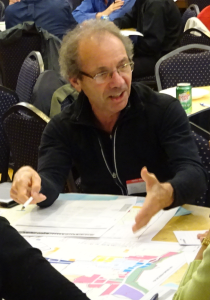 Aldershot resident Tom Muir is usually direct, at times abrasive and always looking for clear answers. When I worked in government, that’s how things were done, just find the cuts, and there were and are no sacred cows.
Certainly, not everything in the budget is needed in the time stated. What’s done is a function of input and time. The first can be reduced some and the time to completion can be extended. Put off spending now to save some. Elementary things we are supposed to teach children about money management.
If the city wants affordable tax rates for residents and business then get going on dealing with the exponential trend that will never deliver such a thing – only a crunch.

 By Pepper Parr By Pepper Parr
January 15th, 2016
BURLINGTON, ON
The crowd that rides the GO train and those who drive the QEW collectively make up the bulk of the people who think about the economy, where we are going as a country and how their home town Burlington is coping.
Before too many noses get out of joint over that opening paragraph, I did say the “bulk” – not all the people who think in this city.
 How soon might we see a functional club house at the Nelson Stadium? These are the people that sit on community committees with their friends and neighbours – the Nelson Stadium Revitalization group is one example, the Rural Burlington Greenbelt Coalition is another. Burlington has dozens and dozens of strong community based groups.
They are aware of our fragile economy, they see the impact and deal with the stuttering economic growth – and they read – and they hear about the federal plans to take on some debt and build or upgrade our infrastructure.
How much of that infrastructure upgrading money is going to get spent in Burlington? And what will it gets spent on? Surely some of it will go into the roads that the current city council says we are millions of dollars behind on.
But what else – what has city hall got on hold that could be rolled out tomorrow if the dollars were available.
Well Councillor Jack Dennison would be close to the front of that line with a move to get the pool at Nelson started.
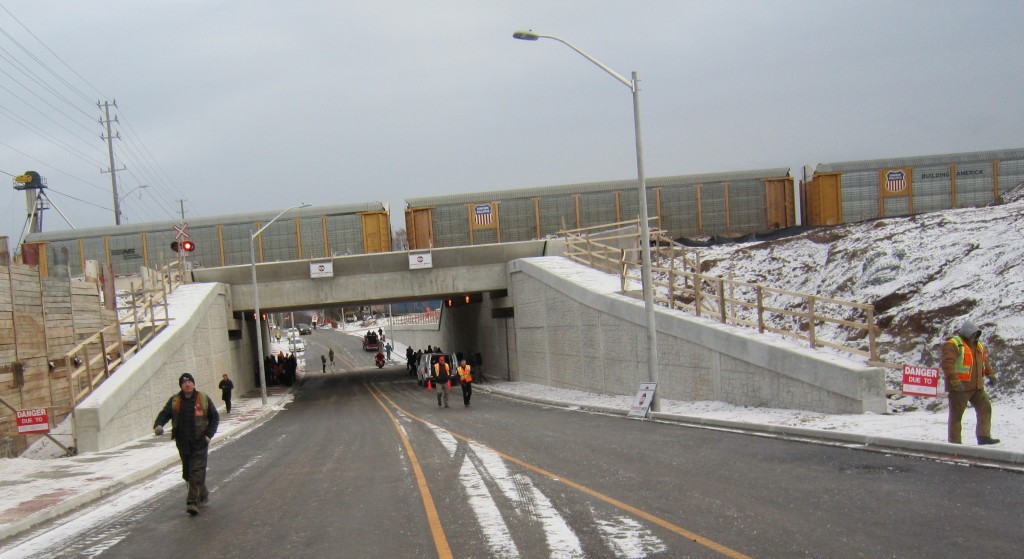 Are the Mainway and east end rail crossing next on the grade separation list? Then there are the two remaining rail grade separations that are on the books: Mainway and the crossing in the east end.
 A plaza with trees liberally spread out – where can you see that in this city? Mapleview? Burlington Mall? Would someone at city hall begin to work with the owner of the Lakeshore Village Plaza and find a way to integrate the city holdings with the private property and get something happening out there? The architect on that project has put forward some excellent ideas and the community took part in a meeting more than a month ago on what they would like to see. City hall has yet to report on just what the 300 plus people had to say at that community meeting.
Would the city want to nudge the Region and fast track the building of the Beachway Park?
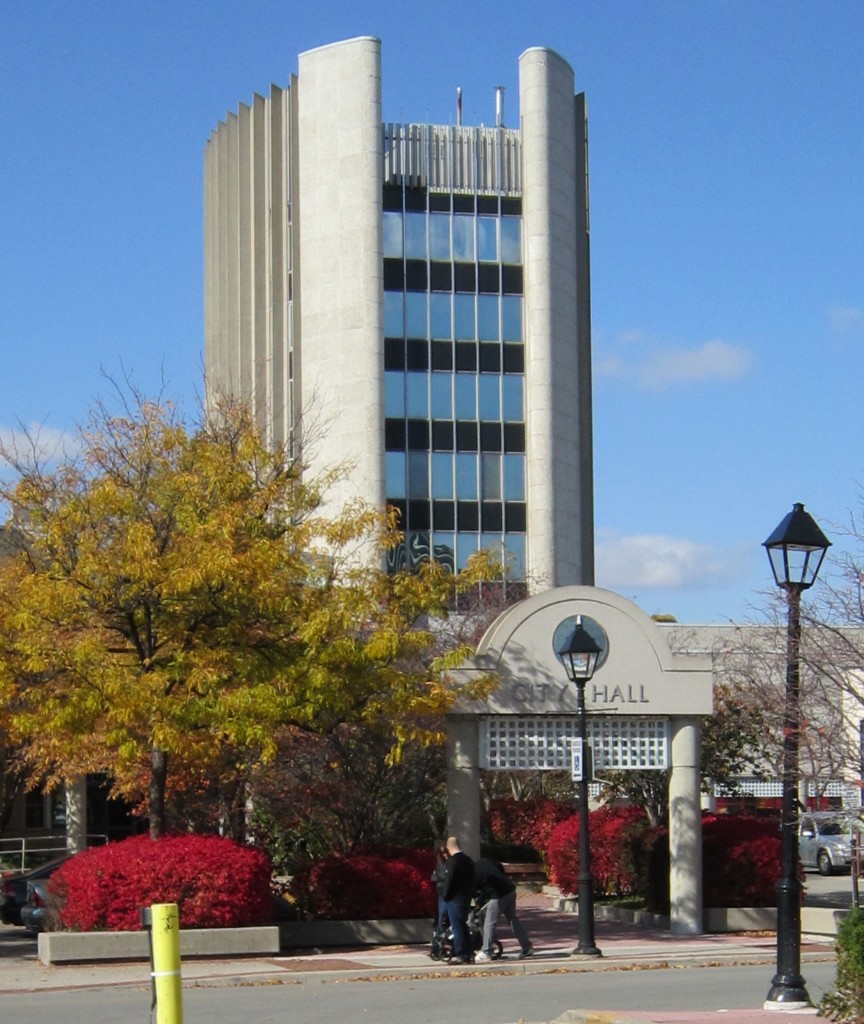 Has city hall passed its best before date? There is a fat file in a cabinet somewhere at city hall with a detailed report on what the city needs in terms of space and also sets out how deficient the city hall itself actually is. We are currently renting office space across the street from city hall.
There is a golden opportunity to goose up the never quite vibrant enough downtown and give it some life. Those who continually tell us that downtown is vibrant have jobs that depend on that sleight of hand. Were we to admit that we have failed with our downtown core – those people would need to find jobs doing something else.
What are we missing here?
There is hardly a word coming out of city hall on what they have in the way of ideas and projects that can be made close to “shovel ready”.
The Mayor hasn’t held a press conference this term – the only real press conference he held in his first term was when the city explained how the pier fiasco was settled out of court – and on that occasion he got the city manager to do all the talking.
The current city manager is basically media adverse.
While we have an economy that is struggling, a dollar that is worth 70 cents; oil that is running at about $30 a barrel – but doesn’t seem to have brought gasoline prices down, we are still a people of ideas and energy and we have within us the capacity to make things happen.
Would someone actually do something – soon?

 By Vince Fiorito By Vince Fiorito
January 13th, 2016
BURLINGTON, ON
At the beginning of each new term, the City of Burlington Council develops a strategic plan, which reflects Council’s vision and strategic priorities for its term of office and beyond. A strategic plan is a document that provides a framework for future City of Burlington decision making and resource allocation. The result should be a document with specific, measurable, attainable, relevant and time bound objectives and key performance indicators.
 Strategic Plans are usually four year plans prepared by a city council. The process to develop the City of Burlington’s 9th Strategic Plan started in December 2014 and should have been completed by December 2015.
This document should take less than a year to consult all stakeholders for input, develop a draft version for consultation and feedback, before City Council ratifies the final version.
Here we are in 2016, and the city still has a few more public consultations to complete and a significant amount of stakeholder input to process before a final version can be put to a vote before city council. I suppose better late than never.
If you plan to attend one of the public sessions, don’t expect to have much time to add your ideas. The format is to divide the audience up into five groups and rotate through five stations, each with a topic to discuss and a communication facilitator. New ideas are welcome, but you will have to compete for time with other participants. I recommend being prepared to submit your ideas to the session moderator in a written format at the end of the session in case time constraints restrict your ability to share your ideas.
As much as I would like to feel warm and fuzzy about how good the City of Burlington is, we do not having a strategy to address invasive species, pollution, climate change and other problems which threaten our natural heritage system.
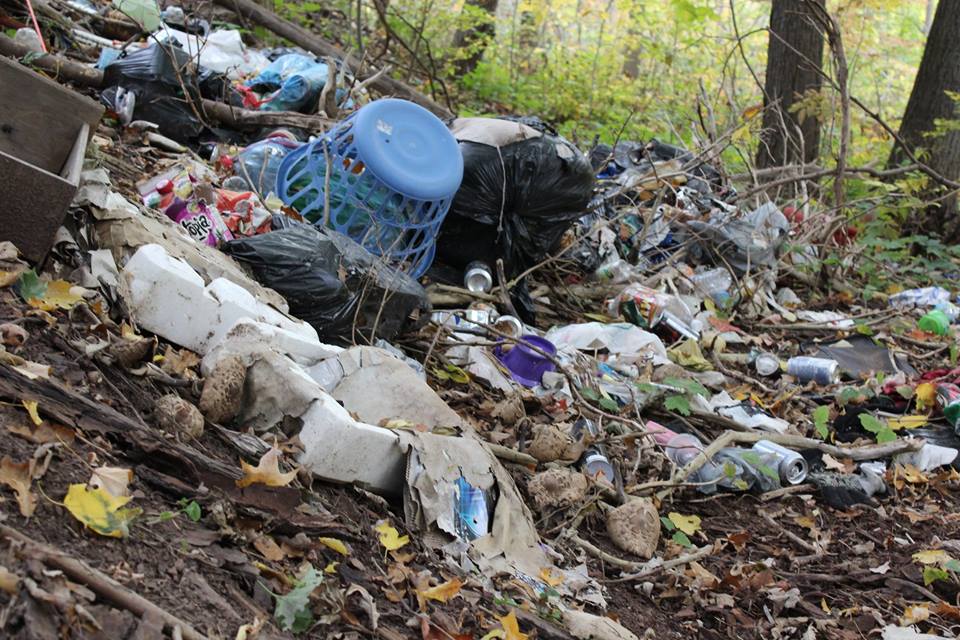 Trash dumped into creek ravines. The City of Burlington has about 20 urban creek valleys which run through the heart of our city. These areas are currently neglected, overrun with invasive species, littered with hundreds of tons of trash and contaminated with fertilizer and road salt residue.
 Fish from Sheldon creek Despite these serious problems, Burlington’s urban creek system act as wildlife corridors and support a wide diversity of native species including trout, salmon, mink and great blue heron.
Clearly the city could add the Green Belt objectives and our urban creeks to the Strategic Plan, but, for whatever reason, has chosen to continue to neglect these urban green spaces within walking distance of most city residents.
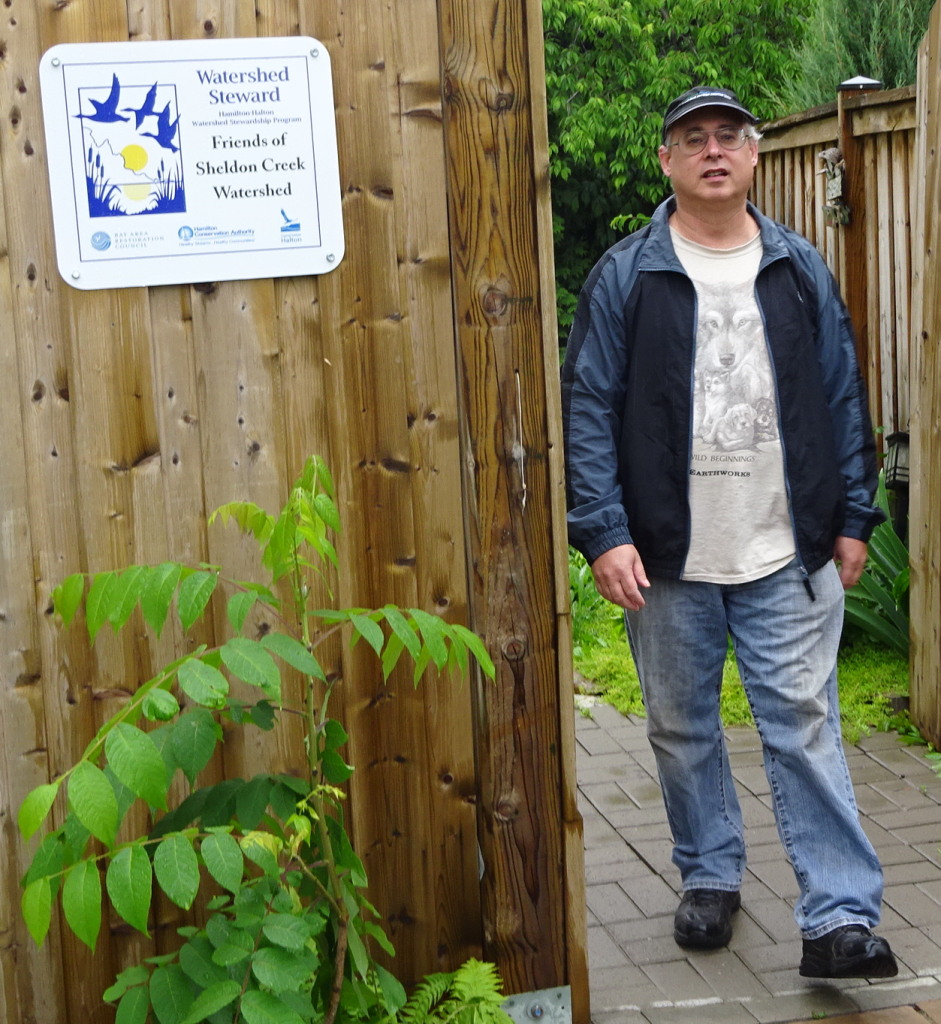 Conservation Halton made Vince Fiorito a watershed steward – Sheldon Creek is his territory. I live on Sheldon Creek and founded the Friends of Sheldon Creek Stewardship organization. Ideally I’d like every resident and business adjacent to one of Burlington’s urban creeks to be considered waterfront property. I am disappointed that the strategic plan has no plan to protect, conserve and restore these natural areas. It’s not like I haven’t tried to raise awareness. I’ve submitted the above information as a delegation to city council and to the Sustainable Development Committee. What does that say about Burlington as an Engaging City?
Another missing component in the Strategic Plan is Climate Change and a plan to reduce the city’s greenhouse gas emissions. The strategic plan states that by 2040 the “city’s operations are net carbon neutral”.
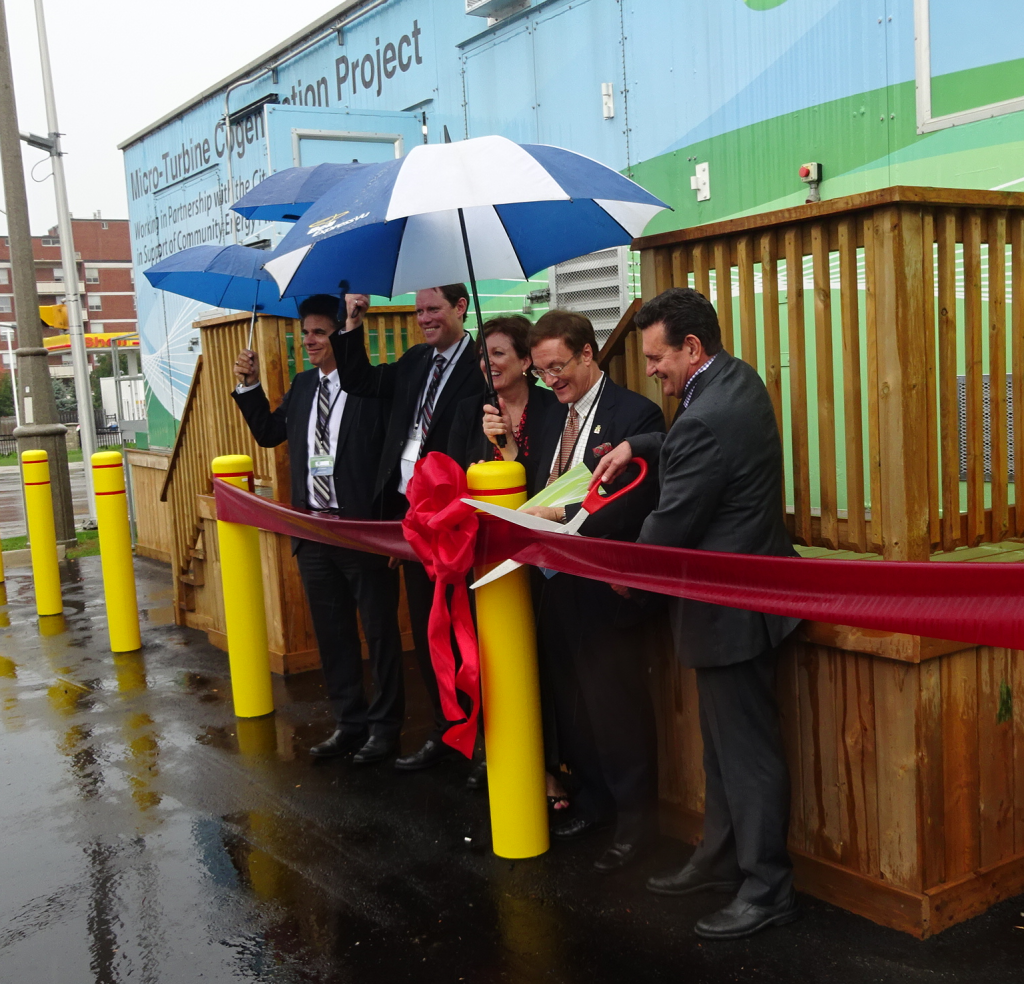 The hydro plans to increase micro-generation of electricity using natural gas, would increase the city’s greenhouse gas emissions. However, the strategic plan lacks anything on how to achieve that objective. In fact, the city’s plans to increase micro-generation of electricity using natural gas, would increase the city’s greenhouse gas emissions.
Overall the draft of Burlington 2015-2040 Strategic report gets a C- in my opinion with an F on the environment.
The final public sessions for input to the Strategic Plan are:
Strategic Plan Open House
Jan 18, 2016 07:00 PM – 09:00 PM
LaSalle Park Pavillion
Strategic Plan Open House
Jan 18, 2016 07:00 PM – 09:00 PM
Mountainside Recreation Centre

 By Staff By Staff
January 12, 2016
BURLINGTON, ON
BurlingtonGreen put its two cents on the table and gave city council and senior staff its views on the Strategic Plan that is currently out for public review.
They made several significant points: One being that there wasn’t enough focus climate change and they wondered why there was a long term vision but not much in the way of a four year, single term of office document. Burlington Green isn’t the only group asking that question.
Burlington Green’s Executive Director Amy Schnurr points to “the extensive community feedback” they received through their Greenprint for the Future outreach program where they learned what the citizens of Burlington had to say about a variety of local environmental issues.
 Ice birgs are melting. “Both globally and locally, the health of the environment and need for effective, results-oriented action to ensure a sustainable future has never been more important. Municipalities have an essential role to play in combating climate change and must prioritize and integrate associated action strategies into short and long-term planning. Additionally, with Burlington currently facing the conflicting challenges of build-out and population growth, the associated issues of intensification, infill practices, habitat destruction, local food security, waste management and effective transportation, combine to make sustainable planning a top priority.”
BurlingtonGreen strongly believes that climate change and the environment must be central to Burlington’s vision and planning going forward and respectfully offers the following input to aid the City in improving the draft Strategic Plan for 2015 to 2040.
Issue: Strategic Plan versus Long Term Vision: we feel the current document represents a strategic vision, rather than a plan which requires specific, measurable time-bound strategies.
Recommendation: Re position the document as “Burlington’s Vision for 2015 to 2040”and develop a five year Strategic Plan in consultation with the community, to implement the short and long term elements of the vision.
Issue: The Vision Statement “Where people, nature, and business thrive” is missing the element of community context.
Recommendation: Include the word “community”, so that the vision statement reads: “Where people, nature, business, and community thrive”.
 Smoke stacks are killing us. Issue: Climate Change: the document makes no reference to this, the most important environmental and social issue of our times, and though some elements, such as the City’s carbon-neutral proposal, address it in part, there is no cohesive or strongly-stated strategy articulated. Cities must be on the front line of action in dealing with climate change, and Burlington needs to demonstrate clear leadership here.
Recommendation: Add a fifth section to the plan dedicated to climate change because strategies dealing with climate change must include or involve all sections of the plan: not just health and environment, but also transportation and economic development and the type of growth we want to have and can sustain in the next twenty five years.
If it is deemed that an additional section cannot be added then all document sections should be strengthened significantly to integrate climate change mitigation and adaptation planning strategies.
Issue: A City that Grows: we support the thrust towards intensification and smart growth; however, there is insufficient recognition of the need to develop and preserve a livable and environmentally sustainable community, while promoting economic growth.
Smart growth must advance strategic plans that respect nature’s biodiversity and our irreplaceable green spaces that Burlington is fortunate to have. This additional point is not only important for Burlington citizens, but is fundamental to promoting economic growth in a postmodern information economy.
Reccomendation: Strengthen this section to clearly indicate that the vision is to absorb growth in the currently defined urban areas to support an economically strong, livable and environmentally sustainable community.
Issue: A City that Moves: we strongly believe that a much greater focus on public transit and active transportation is required in the draft plan.
 Do we have enough buses and are they the right size to meet the changing demand? Recommendation: Make Public Transit and Active Transportation priorities by creating a dedicated section specifically dealing with “public transit” and “active transportation options”, in coordination with the Region of Halton’s recently published Active Transportation Master Plan, and where necessary, work proactively with the Region to suggest any improvements to the Plan that are needed to meet Burlington’s specific requirements.
Issue: A Healthy and Greener City: we find this section represents a fairly traditional approach to environment and more innovative and integrative thinking and strategies, with a strong focus on Climate Change are required.
 Tree canopies like this take decades to mature – is there a plan in place to replace these trees when they begin to fail? It is streets like this that give Burlington much of its character and value. Recommendation: Review this section approaching urban and growth issues from an environmental point of view, and ensure the inclusion of important issues such as:
• Green Space: include strategies for green space growth and preservation for its carbon sink capacity and quality of life and health benefits.
A comprehensive (city and privately owned) green space inventory and acquisition plan is required to support this;
• Tree Canopy: include strategies to protect and strengthen our tree canopy to meet Environment Canada’s community sustainability standards.
One example includes the establishment of a practical, effective private property tree bylaw given that the majority of our tree canopy is located on privately owned lands.
• Habitat & Biodiversity Protection: A balanced approach to development planning is essential to ensure the city’s natural areas are preserved and habitat restoration work is advanced to ensure local biodiversity is protected and enhanced.
• Waste Reduction: include municipal and community strategies to support the Region and Province to meet waste reduction goals. Advancement of the city’s green procurement strategies and establishing local targets, incentives and requirements for all events and festivals conducted on city property are a few examples.
• Energy: consider whether energy, being at the fulcrum of climate change, should be a distinct initiative in this section and perhaps whether the section might be renamed Environment and Energy. Include forward looking strategies such as developing community energy systems(s) by engaging industry experts and committing to community energy infrastructure development.
The test for feasibility should not be limited to existing business and geopolitical measures but should include forward looking plans that anticipate changes in support of combatting climate change.
• Farmland/Source Water Protection: include strategies that will strengthen the protection of our vital agricultural sector and water resources such as adopting a Food & Water First policy.
Issue: A Healthy and Greener City: we find this section represents a fairly traditional approach to environment and more innovative and integrative thinking and strategies, with a strong focus on Climate Change are required.
 Do we have a rural farmland policy? Recommendation: Review this section approaching urban and growth issues from an environmental point of view, and ensure the inclusion of important issues such as:
• Green Space: include strategies for green space growth and preservation for its carbon sink capacity and quality of life and health benefits.
A comprehensive (city and privately owned) green space inventory and acquisition plan is required to support this;
• Tree Canopy: include strategies to protect and strengthen our tree canopy to meet Environment Canada’s community sustainability standards.
One example includes the establishment of a practical, effective private property tree bylaw given that the majority of our tree canopy is located on privately owned lands.
• Habitat & Biodiversity Protection: A balanced approach to development planning is essential to ensure the city’s natural areas are preserved and habitat restoration work is advanced to ensure local biodiversity is protected and enhanced.
• Waste Reduction: include municipal and community strategies to support the Region and Province to meet waste reduction goals. Advancement of the city’s green procurement strategies and establishing local targets, incentives and requirements for all events and festivals conducted on city property are a few examples.
• Energy: consider whether energy, being at the fulcrum of climate change, should be a distinct initiative in this section and perhaps whether the section might be renamed Environment and Energy. Include forward looking strategies such as developing community energy systems(s) by engaging industry experts and committing to community energy infrastructure development.
The test for feasibility should not be limited to existing business and geopolitical measures but should include forward looking plans that anticipate changes in support of combatting climate change.
• Farmland/Source Water Protection: include strategies that will strengthen the protection of our vital agricultural sector and water resources such as adopting a Food & Water First policy.
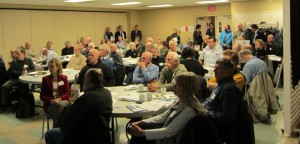 A rapt audience listens to an overview of a budget – did they have any real input ? Issue:
An Engaging City: we generally support what is here, however as a Blue Dot community, Burlington needs to step up to the commitment and advance a plan to stimulate citizen engagement specifically in regards to growth and environmental issues.
Recommendation: Advance plans to stimulate meaningful citizen engagement with respect to growth and environmental issues.
Burlington Green has been consistent with its plea that the public be listened to and heard. They argue that the City’s Strategic Plan for 2015-2040 “must reflect this commitment; they hope the constructive input and recommendations provided make it into the final document.

 By Vince Fiorito By Vince Fiorito
January 9th, 2015
BURLINGTON, ON
Respectfully, I must disagree with Premier Kathleen Wynne that the LCBO should control marijuana sales in Ontario. If the only issue associated with selling recreational drugs like tobacco, alcohol and marijuana was just keeping them out of reach of our youth during their formative years then I would agree. I would also add that the LCBO and Brewers Retail are models of environmentally friendly packaging and recycling. Bravo.
 “My problems with the LCBO and Brewers Retail are their size, their undue control of the alcohol industry as a regulated monopoly and their limited liability. These organizations have a profit motive to promote and encourage increased alcohol consumption. These organization do not fund drug rehabilitation and counseling programs to reduce the harm to the individual and society from recreational alcohol consumption. ” A large powerful corporation like the LCBO would influence and eventually dictate government policy and control production, like they do now regarding alcohol. Not every bottle of wine or beer gets on an LCBO shelf, to the detriment of small wineries and microbreweries. “My problems with the LCBO and Brewers Retail are their size, their undue control of the alcohol industry as a regulated monopoly and their limited liability. These organizations have a profit motive to promote and encourage increased alcohol consumption. These organization do not fund drug rehabilitation and counseling programs to reduce the harm to the individual and society from recreational alcohol consumption. ” A large powerful corporation like the LCBO would influence and eventually dictate government policy and control production, like they do now regarding alcohol. Not every bottle of wine or beer gets on an LCBO shelf, to the detriment of small wineries and microbreweries.
Recreation drug policy goals should include educating the public on the risks associated with recreational drug use, with a long term objective to decrease demand.
I believe in a “least harm” approach to guide marijuana decriminalization. I believe that current marijuana laws are more harmful to society and the individual than marijuana use itself. I support marijuana legalization, provided marijuana consumption is regulated to reduce harm to the individual and society. We should not allow large powerful corporations in this business as they become too powerful and difficult to control. For example, because the LCBO is so powerful, we are currently stuck with a system which promotes and encourages alcohol consumption to the benefit of other large corporations and small producers cannot compete fairly with large corporations.
We should not make the same mistakes with the emerging recreational marijuana industry as we already made with the recreational alcohol industry, that are now difficult to change.
 Marijuana on sale $8 a gram – wide selection. The marijuana industry should be deliberately regulated as sole proprietorships and partnerships to maintain control and create the maximum number of small businesses and jobs. Corporations with limited liability and profit sharing should be kept out of the recreational marijuana industry. Only those directly involved should share the risk and reward of marijuana production, distribution and sales. No profit sharing with limited liability. Overt public advertising should be prohibited, respecting the rights of parents to control what their children know and people who don’t want to see, hear or know about it. A simple standardized symbol over the door of a discreet marijuana cafe is enough.
 People entering a marijuana establishment give implied consent to see legal advertising and promotions inside. Locations of marijuana shops should be strictly controlled by municipal government through zoning and by laws, and they may levy additional taxes. Marijuana production, distribution and sales should be monitored closely for abuses and if the owner/operator breaks the law, they lose their marijuana licenses and face punitive sanctions. Fines for smoking marijuana in public places, similar to tobacco. People may grow a few plants for personal use, similar to vegetables. Need a license to sell. People entering a marijuana establishment give implied consent to see legal advertising and promotions inside. Locations of marijuana shops should be strictly controlled by municipal government through zoning and by laws, and they may levy additional taxes. Marijuana production, distribution and sales should be monitored closely for abuses and if the owner/operator breaks the law, they lose their marijuana licenses and face punitive sanctions. Fines for smoking marijuana in public places, similar to tobacco. People may grow a few plants for personal use, similar to vegetables. Need a license to sell.
Corporate control of the marijuana industry, which promotes consumption could lead to marijuana becoming as big of a problem for the individual and society as alcohol is now. If we can’t implement this change in a way that reduces harm to the individual and society, then I would rather marijuana remained illegal with a punitive fine for possession.

 By Staff By Staff
January 8th, 2016
BURLINGTON, ON
 The Halton Regional Police Service, Burlington station, reached out to the public for help locating wanted persons and hold them accountable for their actions. The results of this initiative were impressive. The Halton Regional Police Service, Burlington station, reached out to the public for help locating wanted persons and hold them accountable for their actions. The results of this initiative were impressive.
Week 1 – Raymond FRENCH (WANTED)
Outstanding charges for stealing $15000 from a senior’s home whom he befriended
Week 2 – Curtis KOMP (ARRESTED FOUR DAYS AFTER THE RELEASE)
Located and arrested in Ottawa as a result of several tips to police from the public
Remains in custody awaiting trial
Week 3 – Kenneth MOODIE (WANTED)
Several outstanding charges for Drinking and Driving related offences
Week 4 – Scottie RYERSON (ARRESTED SAME DAY OF RELEASE)
Accused turned himself in to Halton Police as a result of the media release and attention
Week 5 – Mark AUBERTIN (ARRESTED IN HAMILTON)
Several outstanding charges in Halton for Break and Enter Commit x 8, Mischief under $5000 x 8, Fail to Comply Recognizance x 6, Possession of Break and Enter Instruments x 2, Possession of Stolen Property, Possession of a Controlled Substance and Fail to Attend Court
Week 6 – Michael RAMSAY (ARRESTED)
Accused turned himself in to Halton Police as a result of the media release and attention, arrangements made through his lawyer.
Week 7 – Milan SUCHY and Blanka DOLEZALOVA (WANTED – PARTIES RESIDING OUT WEST, ONGOING EFFORTS TO EXECUTE WARRANTS)
Accused have outstanding charges for Fraud Under $5000, Theft Under $5000, Possession of Stolen Property x 2 and Fail to Re-Attend Court.
Week 8 – Sean KELLY (WANTED) and Jessica HAYNES (ARRESTED)
Jessica was located and arrested in Waterdown by Burlington CIB officers as a result of information received.
Sean remains wanted on outstanding charges for Fraud Under $5000, Theft Under $5000, Personation with Intent and Fail to Re-Attend Court.
Week 9 – Bryon BULLIED (WANTED)
Several outstanding charges in relation to stealing from an elderly male who was confined to his home
Outstanding charges include Theft under $5000 x 3, Unauthorized use of a Credit Card x 3, Fail to Comply with Undertaking, Breach of Probation Order
Accused is also wanted by Ottawa Police for Possession of a Substance x 2, Breach of Probation x 2 and Fail to Appear
Week 10 – Brennen BOWLEY (ARRESTED)
Accused turned himself in to Hamilton Police.
Accused had several outstanding charges with Halton Police, Hamilton Police and Niagara Police
Outstanding charges include Break and Enter Place, Dangerous Operation Motor Vehicle, Fail to Re-Attend Court, Fail to Comply Recognizance x 12, Possession of Property Obtained by Crime, Possession under $5000 x 3, Possession over $5000 x 2, Fail to Comply Probation x 2, Break and Enter Commit x 2, Theft under $5000 and Theft of Motor Vehicle
Week 11 – Corey Rodgers (ARRESTED)
Wanted for Assault with a Weapon, Assault and Fail to Attend Court
Week 12 – Marcin SYDOR (WANTED)
Wanted for Theft over $5000, Theft under $5000 x 3, Break and Enter with Intent, Mischief under $5000 x 2, Possession of Property Obtained by Crime, Breach of Probation and Fail to Re-Attend Court
The accused is also wanted by Hamilton Police for Fraud over $5000, Fraud under $5000 x 7, Breach of Probation, Fail to Comply Recognizance x 2, Breach of Undertaking x 2, Possess – Use of Credit Card x 29
Week 13 – Michael CRICK (ARRESTED), Ashley JACOBS (WANTED) ( JACOBS currently residing in Quebec, efforts on-going to execute her warrants)
JACOBS is wanted for Assault, Breach of Probation, Fail to Comply Undertaking and Fail to Attend Court
CRICK was wanted Theft under $5000 x 2, Fail to Re-Attend Court and Fail to Comply Probation
Week 14 – Ahmad ALAMI (ARRESTED)
ALAMI was located and arrested by Niagara Police as a result of tips received
Week 15 – Beth MICHAUD (ARRESTED)
MICHAUD surrendered to Police as a result of pressure associated with her media release
Week 16 – Darnell PARCHMENT-YATES (ARRESTED)
PARCHMENT-YATES was wanted for Theft under $5000 x 4, Possession of Property Obtained by Crime x 2 and Fail to Appear Court
Week 17 – Korde HILL (WANTED)
HILL is wanted for Theft of Motor Vehicle and Possession of Stolen Property
HILL is also wanted by Six Nations Police Service for Possession of Break and Enter Instruments, Occupy Motor Vehicle without Consent and Possession of CDSA
Week 18 – Matthew PARSONS (WANTED)
PARSONS is wanted for Theft under $5000 x 2, Possession of Schedule III x 2, Fail to Re-Attend Court and Fail to Appear Court x 3
Week 19 – Ryan Andrew WOOD (WANTED) (Believed to be in BC, efforts on-going to execute warrant)
WOOD is wanted for Trafficking Schedule I, Fraud under $5000, Public Mischief, Fail to Comply with Recognizance x 2, Fail to Re-Attend Court x 2
He is also wanted by Hamilton Police Service for Possession for the Purpose of Trafficking – Schedule II, Production Schedule II – Marihuana and Fail to Re-Attend Court
Week 20 – Joshua WEEDMARK (WANTED)
Weedmark is wanted for Mischief – Interfere with Law, Mischief under $5000, Fail to Comply with Probation and Fail to Re-Attend Court
Week 21 – Christian Stuart DRENNAN (ARRESTED)
Possession of a Schedule I, Possession of Schedule II, Care or Control – Impaired, Fail to Re-Attend Court
Week 22 – Brennan HOWE-PATTISON (ARRESTED)
Assault with a Weapon, Assault, Mischief under $5000, Breach of Probation
Week 23 – Trevor Grant ADAMS (ARRESTED)
Assault with a Weapon, Assault, Mischief under $5000, Breach of Probation
Week 24 – Michael DAWE (ARRESTED)
Possession of a Weapon – Dangerous Purpose, Unauthorized Possession of a Weapon, Conspiracy to Commit and Indictable Offence, Fail to Re-Attend Court
Week 25 – Vezio CARDULLO (ARRESTED)
Theft under $5000 x 3
Week 26 – Beth MICHAUD (ARRESTED)
Fraud under $5000 x 2, Uttering Forged Documents x 2 and Fail to Appear Court x 2
Week 27 – Jordan MILLER (WANTED)
Possession of Stolen Property under $5000, Breach of Probation Order x 2
Also wanted by Brant OPP and Brantford Police
Week 28 – Donald Ray McGILL (ARRESTED)
Driving while Impaired, Driving over 80mgs, Fail to Re-Attend Court
Week 29 – Scott MacDONALD (ARRESTED)
Theft under, Fail to Comply Undertaking x 2, Fail to Comply Probation
Week 30 – Nicholas SAWADSKI (ARRESTED)
Theft under $5000, Fail to Comply Probation, Fail to Re-Attend Court
Week 31 – Samantha Rose DUNLOP (WANTED)
Theft under $5000, Fail to Comply Undertaking x 2, Fail to Comply Probation
Week 32 – JASON KEARNS (ARRESTED)
Possession of Ammunition while Prohibited, Possession of a Firearm while Prohibited, Knowledge of Unauthorized Firearm, Possession of a Prohibited/Restricted Firearm, Unauthorized Possession of a Firearm, Breach of Firearms Regulation, Possession for the Purpose – Cocaine
Week 33 – Rob NELSON (ARRESTED)
Drive Impaired, Fail/Refuse Breath Sample, Fail to Appear Court
Week 34 – Benjamin BRZEZINSKI (ARRESTED)
Theft under $5000 x 2, Fail to Comply Probation x 4
Week35 – Kerry Lee HENWOOD (WANTED)
Theft under $5000 x 3, Use of Credit Card x 7
HENWOOD is also wanted by Hamilton Police Service for Fraud under $5000 x 7
There are numerous people who continue to evade the police and the court system and continue to live out in our communities while having a warrant for their arrest in place. Every Friday, the Burlington Offender Management Unit will share information on a wanted person in hopes that the public can assist in locating the individual.
The police share “Fugitive Friday” information on their website and via social media through Twitter @HRPSBurl and @HaltonPolice.
“The 2015 Fugitive Friday project has been a success as the sharing of information publicly has led to numerous wanted person being arrested and brought to court to answer to the charges against them. It is due to our concerned community, those that helped spread the wanted information via social media, that we have affected 23 arrests out of 37 wanted persons” said Detective Constable Calvin Bulbrook, the officer who brought the idea to Burlington..
Anyone who may have witnessed these wanted persons or has information that would assist investigators in locating them are encouraged to contact D/C Bulbrook – Burlington Criminal Investigations Bureau – Offender Management Team at 905-825-4747 Ext. 2346 or Crime Stoppers at 1-800-222-8477 (TIPS), or through the web at www.haltoncrimestoppers.com, or by texting “Tip201” with your message to 274637 (crimes).
Comment on the Fugitive Friday initiative and the role media plays.

 By Pepper Parr By Pepper Parr
January 8th, 2016
BURLINGTON, ON
The Halton Regional Police released the results of their Friday Fugitive initiative today – the results are impressive – 23 of the 37 people they were looking for were arrested.
Pictures of each of the wanted people, provided to us by the police, were published by the Gazette.
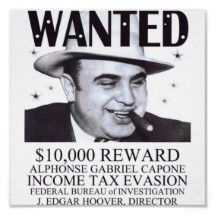 Publishing this picture now is entertainment. Some of these people had very long criminal histories and would appear to still be living the life of a criminal. Several were preying on older people unable to protect themselves. Many of the people the police were looking for were wanted for failing to appear before a judge once they were released on bail.
 Is publishing this picture also entertainment – the person happens to be a very dangerous individual. The police spend a lot of time and financial resources apprehending the people wanted for committing criminal acts. They get to court and are released on bail – which means the police have to go looking for them all over again.
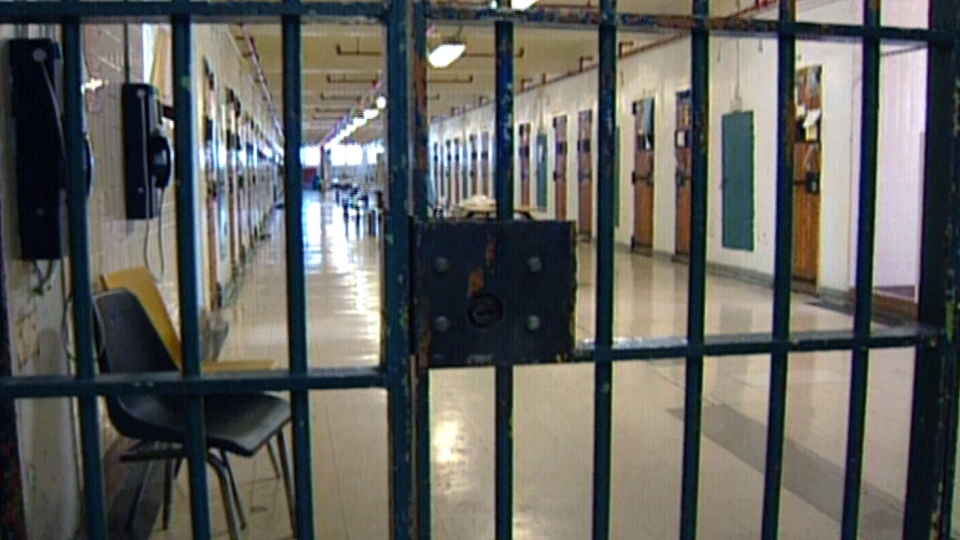 Jails are expensive places to operate. Should we jail people who fail to appear for a court hearing? If we don’t – what happens to public respect for the justice system? Keep them in jail would seem to be the sensible thing to do. Problem with that is keeping people in jail is an expensive proposition. The criminal justice system seems to prefer to let them out and then have them re-arrested. Cheaper – but it also impacts on the respect the public has for the criminal justice system. For the rule of law to be effective there has to be strong public respect for that rule of law. Without it – we slide into anarchy and that is not a pretty picture.
 Commonly called “super max” it is a provincial jail in Penetang where dangerous people are kept for long periods o time. There are frequent riots at this jail. We are a civilized society with some very intelligent people working at the justice ministry – the public deserves to have the problem of how we handle people who consistently fail to appear in court when they are released on bail.
Our member of the provincial legislature might want to tackle this problem and see what she can get done.
As we reviewed the Fugitive Friday initiative, looking at the pictures of the people the police wanted to apprehend we were struck by the number of very young men who had run afoul of the law. Some of them were not much beyond boys and we wondered if we were serving a useful purpose by publishing their pictures know that once on the internet they are there for a long time – a long long time.
The Gazette has heard from several of those the police arrested in the past asking us to take down their picture. Is that our role?
Are we to be the judges of whose picture stays up and whose picture does not remain in the public domain?
One young man had several people write on his behalf – and we took the picture off the internet – but that really isn’t the role media plays.
At some point some prominent personality will have a relative or a family member that got themselves into a spot of trouble, made it into the media and asked if we could just quietly delete what was written.
It troubles us – is that our role? We don’t think so.
Do we remove all those who have been arrested and just keep those the police are still looking for?
Whose interests did we serve by publishing the results of the 2015 Fugitive Friday successes?
Do we know if the people who were wanted were actually found guilty?
What if they were acquitted – do we have the right to keep the “wanted by the police” information on the Gazette web site?

 By Pepper Parr By Pepper Parr
January 8th, 2016
BURLINGTON, ON
Is here a threat to the nascent growth that has been percolating in the cultural field in Burlington?
Last year there were a number of events that took place which added to the health of local culture – one being the national Culture Days initiative that was developed to create a source of information on events taking place across the country and to promote those events.
Local artists could post their event and communities were encouraged to work locally with artists from every discipline possible.
 Donna Grandid, a noted Burlington artists was front and center during a recent Culture Days event. Burlington climbed aboard the Culture Days train last year and the year before that and the sense was that the city would continue to put resources into the event.
Apparently the city isn’t going to have any staff working on the Culture Days initiative in 2016.
Why not ? – the view appears to be that if artists want the event to happen – then let them make it happen.
Burlington’s growth as a cultural destination is not yet at the point where it can fly on its own; it is going to need nurturing for a number of years.
Burlington has a manager of culture events who has some support from a part time assistant. There are times when culture file gets very busy and additional support is needed.
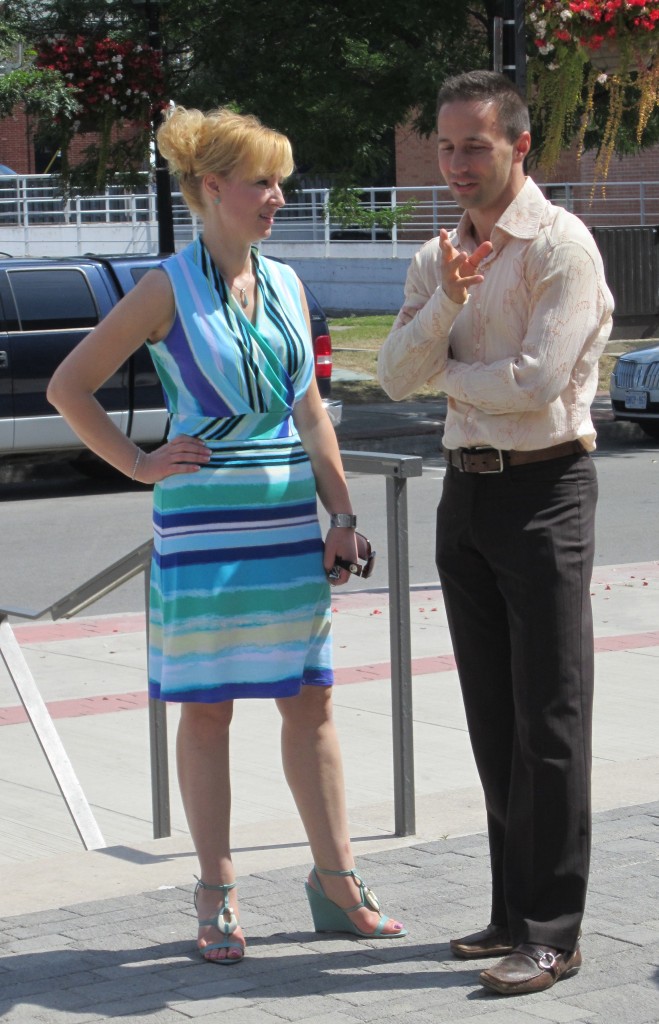 Angela Paparizo and Trevor Copp – both strong advocates for a more robust Burlington with a higher cultural profile. Angela Paparizo is the manager of culture events and was reporting to the one general manager the city had. It isn’t clear yet who Paparizo will report to now that the city no longer has any general managers. The understanding is that city manager James Ridge now chairs the Cultural Action Plan implementation committee.
There was some talk that the culture file will move back into Parks and Recreation where it languished for years.
Culture and sports are two different animals and in Burlington they have not mixed very well in the past.
Fortunately for the arts crowd, the city is in the process of finalizing its operations budget – this is the time for the arts community to delegate and ensure that the gains they have made do not get lost while the city manager figures out what he wants in the way of an organizational structure.
Ridge is focused on getting a Strategic Plan in place; getting a budget approved and then getting back to the Official Plan review that sort of got put on hold.
While there is a Cultural Action Plan along with a Committee to implement that plan, other than the city manager’s blessing it doesn’t appear to have much more propelling it.
The Strategic Plan has cultural arms and legs sticking out all over the place – but as one commentator put it – is the city going to walk the talk?
There is that old phrase that reporters use when they want to figure out what’s going on – follow the money.
How much has been allocated to culture? And then where are the human resources to support what has to be done if culture is to get to the point where it has lift off.
The city has an excellent Performing Arts Centre that has experienced several years of strong successes; the Art Gallery has new leadership – the Museums are still there with Ireland House is a sterling example of how local history can be made part of the cultural scene. Poor Joseph Brant is not getting the same treatment – but with different leadership that too might change.
 Maureen Barry, CEO of the Burlington Public Library and a consummate professional has overseen the move deeper into electronic media yet keeping real books on shelves. There is a clear cluster of cultural nodes in this city – they need to be pulled together and given strong executive leadership.
Who could do that – Maureen Barry – she will shoot me for saying this – but she is one of the best executives we have in the city with a better big picture of culture than anyone else on the horizon.
That’s just an opinion.

 By Ray Rivers By Ray Rivers
January 4th, 2016
BURLINGTON, ON
Job number one for the new federal government will be restoring the good ship Canada.
The previous government will be remembered for its poorly (ideologically) conceived legislation which kept getting overruled by the Supreme Court. Bill -51 (police state), the (un)Fair Elections Act, the Environmental Assessment and the Fisheries acts, and the Safe Streets and Communities Act (mandatory prison sentencing) are but a sampling. Others were typically buried in omnibus legislation so as avoid scrutiny.
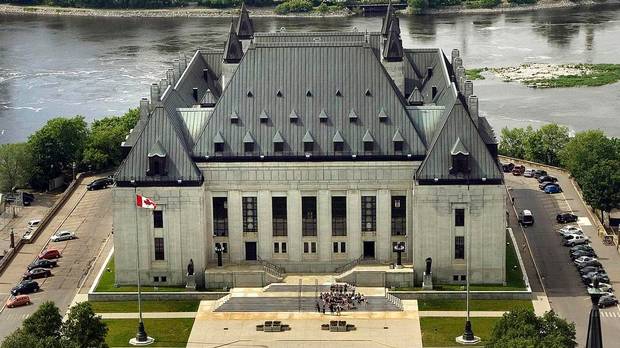 The Supreme Court in Ottawa – not a Court that the Harper government was able to convince very often. It appears the government backdated authority for the RCMP to destroy gun registry records, which is improper if not illegal. This little trick was buried in one of the several omnibus bills that had everything imaginable stuffed into them; an example was the Tory’s signature law, “Ending the Long-gun Registry Act’ .
This long-gun registry has been problematic since its inception, and it is unlikely Mr. Trudeau, who once referred to the registry as a mistake, will be in any hurry to restore it.
And speaking of guns, Canadian war planes are still in action in the Middle East, something which most Canadians seem to agree with. Bringing our six planes home will not significantly affect the fight in that region, although we should be proud of our fly-boys. And it appears that IS, Daesh, ISIL or whatever they call themselves are on the run.
The real danger is that these extremists will end up diminished but not destroyed, holed up in some hideout, and like al Qaeda dropping in to spoil our party from time to time, as they did in Paris.
 How will the ballots be counted in the next federal election? Mr. Trudeau pledged to change the way we elect MP’s, thus making our current multi-party electoral system, known as First-Past-the-Post (FPP), more representative. At least 60% of electors typically vote for someone other than a Conservatives candidate. That implies that moving to a mixed member proportional system (MMP) or a preferential ballot, would ensure that the Conservative Party would never again be able to form a majority government.
Of course all bets are off if the Conservatives were to re-position themselves closer to the political centre. And of course, they could merge with the NDP and then honestly call themselves progressive-conservatives once again.
At a recent biennial policy conference the Liberal party endorsed a preferential ballot, a variation on the FPP. Voters rank their choices on the ballot and, if no candidate gets a plurality, second choices are added to the calculation until someone obtains 51% of the vote. It’s not really as complicated as I’ve made it sound, and the calculations can be done instantly by computers, even if paper ballots are marked. This option is where the smart money can be found.
Still one should never say never – except that our new PM has said never again to the very system which gave him a majority government with less than 40% of the vote. Still it was a larger share of the vote than either Harper or Chretien had obtained. So the Conservatives are demanding a national referendum. Not that Mr. Harper ever held a referendum on any of his legislation, such as the Fair Elections Act.
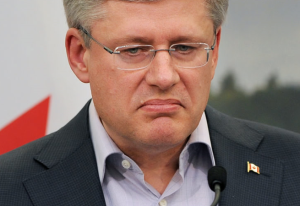 Former Prime Minister Stephen Harper Perhaps our former PM understood that a referendum can be a messy business. Just look at what happened to Brian Mulroney when he rolled the dice and lost the ill-fated Charlottetown Accord. About half of Canada’s provinces have at least considered implementing MMP provincially. And B.C. and Ontario, each held a referendum, which failed to meet their critical thresholds for adoption.
Call it a communications/messaging failure by the governments or see it as a failure to win by deliberate design. The truth is that these once enthusiastic champions for electoral reform seemed to lose interest after they had become the government. Interestingly, New Zealand made the move to MMP back in the 1990’s with considerable backing by the public in their referendum campaigns. More recently the province of Ontario has announced that it will allow municipalities to use ranked/preferential ballots to determine the winners in the next local elections.
 Current Conservative interim leader Rona Ambrose. Nevertheless the new Tory interim-leader is determined to block any change without first polling all Canadians, and has even threatened to use her majority in the Senate. Of course since we are a federation, Mr. Trudeau might want to obtain a sign-off from at least seven provinces comprising 50% of our population (the amending formula for the constitution) before moving forward. That would allow him to withstand a constitutional challenge in the courts, should one be forthcoming.
As for the Senate there are over 20 vacancies which need to be filled, and the government appears to be intent on filling them based on merit, and in a non-partisan fashion. Meanwhile Senator Duffy’s days are almost certainly numbered, though he’ll likely escape with a slap on the wrist. The core of the problem, which even he concedes, is that he should never have been appointed to represent PEI in the first place.
Provincial plans and national targets for climate changing emission reductions will be addressed early this year. And if they are smart, the federal government will work to integrate the various provincial programs into a national framework, including any ‘cap and trade’ or other carbon tax provincial programs.
It is inevitable that there will have to be new incentives for individuals and enterprises to cut emissions, plant trees, etc.. So if you are looking to make renovations to that draughty house or contemplating buying a new car, like me, it might be prudent to wait a few months. And to help pay for these financial incentives expect to see some kind of carbon tax as well as a national cap and trade program. And what about Ontario’s converting its high occupancy vehicles (HOV) lanes into a tollroad – just a teaser or a harbinger of what waits for all of us?
Below are my expectations of what is coming and the probability of occurrence.
• Electors in Saskatchewan will re-elect Brad Wall (60%)
• Electors in Manitoba will vote for a change (70%)
• Ontario will kick off major infrastructure building program (100%)
• Canadian dollar will stay low benefiting Ontario businesses (80%)
• Continued low oil prices will see Alberta trade places with Ontario as ‘have’ provinces (90%)
• A lower dollar will lead to inflation and higher interest rates (60%)
• Ontario pension plan will be a pilot project and rolled into CPP (60%)
• Income taxes will become more progressive at both upper levels of government (50%)
• US electors will get a new president and it won’t be the Donald (100%)
• Eastern Europe will become more tense as Russia/Ukraine conflict continues (90%)
• There will be proxy wars in the middle east between Iran and Sunni Muslim states (80%)
• UK will prepare for BREXIT referenda in 2017 (100%) and stay in EU (60%)
• Canada’s Conservatives move to the middle and prepare for new leader in 2017 (60%)
• Globe and Mail ahead of me (great minds…) with this kind of story (100%)
• I’m going to take a break for a month or so (100%)
 Rivers will read the newspaper rather than write for it as he takes a well earned break. Ray Rivers writes weekly on both federal and provincial politics, applying his more than 25 years as a federal bureaucrat to his thinking. Rivers was a candidate for provincial office in Burlington where he ran as a Liberal against Cam Jackson in 1995, the year Mike Harris and the Common Sense Revolution swept the province. Rivers is no longer active with any political party.
Background links:
Gun Registry Screw-Up Gun Registry Charlottetown FPP
MMP in New Zealand Democratic Reform Ranked Ballots Ontario Looking Forward More Looking Forward
Even More Looking Forward
Food Prices 2016 Big Issues 2016
Tax Avoidance G&M Predictions

 By Walter Byj By Walter Byj
January 1, 2105
BURLINGTON, ON
The six new trustees elected to the Halton District School Board, out of a total of 11, had to accelerate get through a steep learning curve when they found themselves faced with a number of issues that were the legacy of previous boards.
As in the past, the HDSB trustees were model administrators and conducted day to day business in an efficient manner. The introduction of the new Health and Education Curriculum was carefully studied by both the trustees and staff and with the assurance of proper training for the teaching staff the new curriculum was introduced to Halton students with little fanfare.
New schools were built in Oakville and Milton and even though lead time was far from ideal, the schools were built on time with few inconveniences. With the Close the Gap project, the board continued to upgrade older schools so that students would have the same classroom benefits the newer schools have; air conditioning and better access to wifi and library services.
Through the Long Tern Accommodation Plan, they reviewed the status of the various schools within Halton and realized that although Halton as a region had a growing population with the requirement of additional schools, there were areas, such as the south of Burlington, where school attendance was falling and consolidation of schools may need to take place.
 Pineland Public School There were other issues that although identified in 2015 that will be resolved 2016 if not later.
The first thorny issues the trustees faced was the decision that Pineland school be converted to a totally French Immersion school thereby disrupting the ideal of having a community school that served the needs of all those in the neighbourhood. Instead, Pineland was to become a school that was now serving a large swath of students in the south of Burlington who were bused in while those in the immediate neighbourhood would now need to go to a school that was originally outside their boundary.
A numbers game was played justifying the change, but the numbers game were in part a reflection of previous decisions when the French Immersion program was introduced in Halton. No one can ever predict the success of any program, but French Immersion has exceeded expectations to the point where it is now negatively affecting the English program at the elementary level.
The board has formed the Program Viability Committee to fully review and with input from the public provide a solution for upcoming years. As noted before, this will not go down easy in parts of Halton.
Getting to and from school has become problematic within the Halton region. After ceding to the various demands such as larger, friendlier parking lots and curved laneways from both the municipality and public, our schools have become extremely car friendly, resulting in congestion on a regular basis. Combined with one of the more liberal school busing programs, the board is now reviewing how it can encourage more students to use active transportation (walking and biking) as a method of getting to school.
This will continue to be a hot issue for 2016 with potential of much debate.
In January, the board faced the issue of start times for elementary and secondary students. Reviewing studies that stated that school times for secondary students, in some cases are starting too early, the board wanted to alter the start times of secondary students so that the students could have a later start time. However, after much debate and research change would not be easy.
 Any change in school start times would be a logistical nightmare for the bus schedules With many students (elementary and secondary) using school transportation, any change to school times for secondary could affect the start times of elementary students.
Also, the HDSB shares school busing with the Catholic board. A change for one would require the co-operation of the other or face the possibility of going alone. To date, no changes have yet occurred.
The board did question the viability of using public schools as polling stations for the various municipal, provincial and federal elections. The potential for harm to students was the genesis of this review. It is currently in the embryonic stage but ideas such as potential weekend voting have been raised. Any solution would require all three levels of government so do not expect any quick solution on this one.
 David Euale gives retirement a third try – seems to have succeeded this time. In February, after five years as Director of Education, David Euale announced his retirement, effective August 31st, much to the chagrin of the board and staff. With the mandate of finding the best possible replacement, the board started a provincial wide search for a new director. At times like this, some argue that new blood from outside is at times necessary to stimulate and add a different perspective.
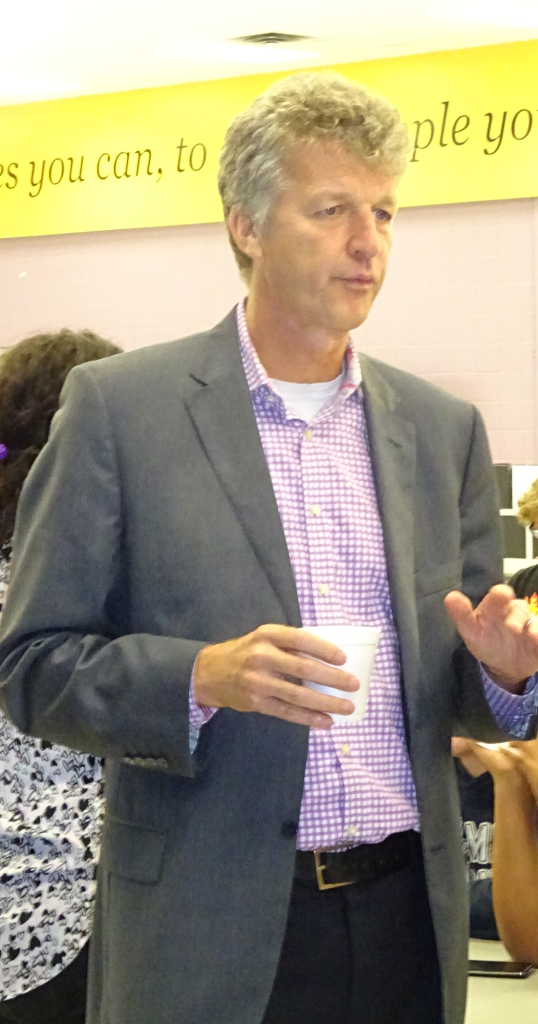 Stuart Miller; Director o Education, Halton District School Board The board decided to promote within and Associate Director of Education Stuart Miller was hired as the new Director of Education. Director Miller is highly respected by both staff and the board and is highly qualified to face the challenges of 2016.
In a thriving democracy, people who are voted into any office are there as representatives of the total population and bring the voice and desires of the mass to an elected body. This would include the highest level in the country, the Canadian Parliament, to elected members of our various school boards. These bodies set out to create policies for not only the immediate future, but also for years in the future. These decisions can lead to the success or potential problems if issues are not properly vetted. So how does the Halton District School Board stack up?
In Burlington, one of the trustees, Amy Collard, was acclaimed while two others, Andrea Grebenc and Richelle Papin received 12% and 13% of registered voters. Leah Reynolds received 17% of registered voters. Based on the number of votes cast, all three were close to or over 50%.
 Is one of these two going to follow the other? Ward 2 Councillor Marianne Meed Ward and school board trustee Leah Reynolds. There is a “geezer” in ward 2 who would like to upset that apple cart. The low turnout is not their fault, they elected to run and it may not be the public’s fault as they themselves may not be familiar with the issues. However, we are electing a group of people to oversee an annual budget of close to $700 million and yet do not vet our candidates. The trustees themselves are not representative of the community as all are female, a rarity in Ontario. This in no way disqualifies them, but once again is not representative. In addition, the majority of trustees are not reflective of the population base within parts of Halton.
There are many within Halton, specifically Burlington that no longer have children attending school. This includes the growing senior’s population. Trustees communicate often with parents within the system but one wonders how often those without children have any input into the decision making process of the board.
With the province of Ontario in a huge deficit position, the flow of money to the public is being reduced and all organizations will need to be creative in finding solutions to limited funding and all citizens need to be included in the process.
 Walter Byj: education reporter. Walter Byj has been the Gazette reporter on education for more than a year. He is a long-time resident of the city and as a parent has in the past delegated to the school board.

 By Ray Rivers By Ray Rivers
December 29, 2015
BURLINGTON, ON
Columnist Ray Rivers looks at 2015 and comments on where we got it right and where we could have done better. Before taking a month off to travel, refresh and get caught up on his reading Rivers will suggest where 2016 might take us.
Justin Trudeau’s decisive victory at the polls has ushered in a new sense of hope and promise. He is just one person but he has ignited a sense of optimism in the land, and the refugee resettlement issue has been an effective policy instrument. A promise is a promise, but does it really matter whether it’s 10,000 people by the end of the year, unless you happen to be one of those refugees, that is.
Having decided to open our doors to those in need has changed the nature of the debate. No longer just an international obligation, immigration is now cast as an investment in our future. Fear of terrorists among the masses has been replaced with a reflection on the benefits previous refugee settling programs have brought us, going back to the early Irish migrations.
 Federal scientists in Canada can now talk about their work. Barely two months into office this new leadership has already shaken up our public service. Scientists are once again allowed to speak openly about their findings, and the long-form census is back, fulfilling vital information needs. The promised middle-income tax cut has already been effected, and a non-partisan process for appointing senators is being developed.
But sooner than later Mr. Trudeau will need to beef up the foot soldiers who carry out his wishes. He’ll need a fully responsive, enthusiastic and capable bureaucracy to implement the government’s political will. Over the previous decade the federal public service had atrophied and in some areas, like environmental management, been decimated. Disillusioned and depreciated, many of the smartest people chose to leave rather than suffer the indignation of serving a government which resented them as burdensome, redundant and a drain on the public purse.
Canada is a federation and it works best when the central and provincial governments are working together, something we’ve seen in spades even in the brief time that the Liberals have been in office, and something that had been missing over the last decade. It may help that most of the provinces are also Liberal, or Liberal friendly, except for Saskatchewan. But a common political stripe doesn’t guarantee harmony, as we saw with the earlier PC government in Newfoundland.
There is a new sense of mutual respect for the positions of others. For example, even though the PM has enough support to revise the Canada Pension Plan, he’s waiting for B.C. and Saskatchewan to climb on board. Climate change is a priority, but since the provinces will be doing much of the heavy lifting they will be a big part of the process, thereby ensuring greenhouse gas reduction plans and targets are truly national – for the first time.
 It is said that a rising tide lifts us all. Well at least Trudeau’s election victory did for the popularity of the newly elected premiers in the Atlantic provinces. But it didn’t do much for the Liberal leaders in Ontario and Quebec. Voter fatigue is a natural phenomena for a government in power as long as the Liberals have been in Ontario. And the polls also reflect the public’s impatience with what it sees as less than satisfactory performance. It is said that a rising tide lifts us all. Well at least Trudeau’s election victory did for the popularity of the newly elected premiers in the Atlantic provinces. But it didn’t do much for the Liberal leaders in Ontario and Quebec. Voter fatigue is a natural phenomena for a government in power as long as the Liberals have been in Ontario. And the polls also reflect the public’s impatience with what it sees as less than satisfactory performance.
The debt and deficits are a problem. But it’s all the other screw-ups which leave one with the sense of lack of competence. And each screw-up makes it harder for a government to recover lost confidence and credibility. Recently the provincial auditor general (AG) claimed that $37 billion was wasted on the electricity file over the last decade. If accurate, that is a powerful lot of money wasted on that file. Is it any wonder most Ontario householders didn’t trust the government to effect the sell-off of Hydro One?
Poor political direction or failed administrative execution? It’s pretty clear that the gas plant fiasco, including the alleged attempted cover-up was almost entirely political. But that only accounts for one-thirty-seventh of the AG’s allegations. If the role of the civil service is to keep the government that is in power, to stay in power, then they are doing a pretty inadequate job on that file. And part of the reason may be that the organization is stale-dated and long overdue for renewal.
 Ontario’s government hasn’t seen much re-organization over the years, certainly not compared to the federal government. One of the boldest attempts at renewal was prescribed in Mike Harris’s common sense revolution. And of course smaller government was always better, in his mind. Well it may have looked good on paper and it won him the election. But as former Harris education minister Snobelen found, creating crises as an approach to organizational re-engineering just leaves you with… chaos. Ontario’s government hasn’t seen much re-organization over the years, certainly not compared to the federal government. One of the boldest attempts at renewal was prescribed in Mike Harris’s common sense revolution. And of course smaller government was always better, in his mind. Well it may have looked good on paper and it won him the election. But as former Harris education minister Snobelen found, creating crises as an approach to organizational re-engineering just leaves you with… chaos.
And whatever good was accomplished by Harris’ red-tape cutting gestapo was soon lost following the Walkerton scandal, in which seven people died after drinking improperly treated water That tragic incident probably had more to do with downsizing than red-tape, but the baby got thrown out with the polluted bathwater anyway. And the result, ironically, was even more rules and more civil servants to enforce them.
 Beer is no sold in supermarkets – but not yet in Burlington. Like most Ontario residents I cheered to the news that beer would now be available in grocery stores. But then I learned of all the rules surrounding what should be a simple transaction for a mildly alcoholic beverage – rules that didn’t seem to apply equally at many of the existing in-grocery wine stores, nor at the many rural LCBO franchise outlets. Was this a case of too many provincial lawyers with too much ink in their quills and too little else to write about – or just more of that nanny-state we’ve grown to love?
One of the provincial Liberals’ campaign promises was to enhance our pensions through a provincial plan. Reducing the inequality between those with an institutional or private pension plan and those without is a liberal ideal. But with E-health and ORNGE in mind it is understandable that there is some lack of confidence in this government’s ability to effectively deliver that program. So, it is no surprise that Ontario residents would prefer the new federal government to do it for us as part of our Canada Pension Plan.
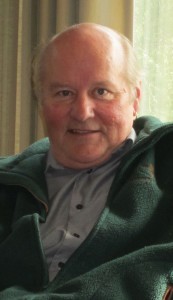 Ray Rivers writes weekly on both federal and provincial politics, applying his more than 25 years as a federal bureaucrat to his thinking. Rivers was a candidate for provincial office in Burlington where he ran as a Liberal against Cam Jackson in 1995, the year Mike Harris and the Common Sense Revolution swept the province. Rivers is no longer active with any political party. Ray Rivers writes weekly on both federal and provincial politics, applying his more than 25 years as a federal bureaucrat to his thinking. Rivers was a candidate for provincial office in Burlington where he ran as a Liberal against Cam Jackson in 1995, the year Mike Harris and the Common Sense Revolution swept the province. Rivers is no longer active with any political party.
Background links:
Rebooting the Public Service Premier’s Positive Outlook A Rising Tide
Creating a Crisis Walkerton

 By Trevor Copp By Trevor Copp
December 29, 2015
BURLINGTON, ON
Trevor Copp is the dancer who brazenly told city council in 2012 that there really was a cultural community in Burlington and Council needed to wake up and pay attention. That fresh start resulted in the creation of the Arts and Cultural Community in Burlington, a significant report on the state of culture in the city and the development of a Culture Action Plan plus the appointment of a Manager of culture at city hall. Copp sees that as just a start.
Last year the star of the cultural community was how many indy ‘up and coming’ local artists/orgs ‘up and came.’
 Kune Hua’s Wish Garden at the No Vacancy event held on Lakeshore Road this year. Selina Eckersall’s No Vacancy – a pop up Art event which was an unthinkable in Burlington five years ago – held its Supernova event this year on Lakeshore.
The Burlington Performing Arts Centre saw its full local professional Series bloom with Tottering Biped Theatre, Nortsur, and Koogle Theatre all presenting works. The AGB’s new Executive Director Robert Stevens has for the first time acquired a piece by an internationally famous public art specialist from Lowville, Walt Rickli.
 The FORM brought some of the most progressive dance the city has seen – great performance poorly attended though. And an all-out first: FORM Contemporary Dance presented the first Burlington original contemporary dance event ever this past Fall.
Add in the Art in Action studio tour, the Burlington Slam Poets competing at the world championship, Symphony by the Bay rocking, and Burly Calling all holding their own beautifully.
This is what will finally get us to come into our own: artists doing it for themselves. We’ve been meeting up a storm at the City and progress is slow. The city is a big boat and takes a long time to turn, with several Councillors still needing convincing that the Arts have a place in our budget, not just our hearts.
Getting the City’s first manager of Culture Angela Paparizo into an office was a highlight – but we need a lot more of that going on so the City hall types can catch up to its people.
In 2016 I’d like to see even more independent artists making things happen. The Burlington Shebang – a multi-year collaboration of many local artists – will culminate at BPAC in May.
 The performance community really wants to see continued growth in for them in 2016 – they are hoping Susan Haines can deliver. She does need some time to put a program together. We’ll see if the new Executive Director at the Performing Arts Centre holds up Brian McCurdy’s vision of supporting local theatres. There’s a lot of possibility out there and we can have it all if we become impossible to ignore.
The City needs to kick in more real money and energy for the local artists: no more plans, we need money on the table. We are putting the ‘url’ back in Borington and this is our time.

 By Vince Fiorito By Vince Fiorito
December 27, 29015
BURLINGTON, ON
2015 was a big year for the environmental movement. It was a year of historic agreements, milestones, diversions, sensible policy making and oversights.
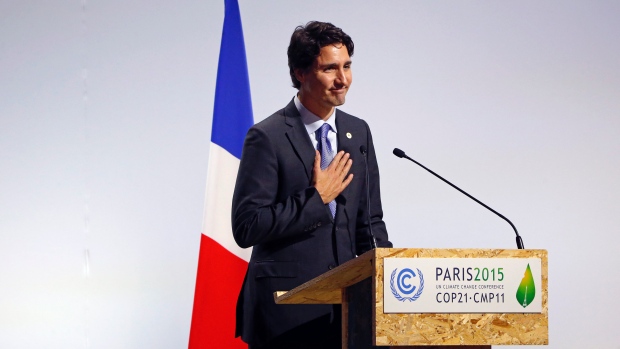 Prime Minister Justin Trudeau at the Climate Change talks in Paris. Internationally, the biggest environmental story was the United Nations Climate Change Conference in Paris which will be remembered both for its achievements and failures. Canada’s Minister of Environment and Climate Change, Catherine McKenna as well as the rest of the Canadian delegation deserve recognition for their efforts to negotiate the historic Paris Agreement. As the Paris delegates were debating, atmospheric CO2 levels passed the 400ppm milestone, which is a 42% increase since the start of the industrial age only 150 years ago. The last time the earth’s atmosphere had this much CO2 was two million years ago. Back then, the earth’s climate was 6C warmer, the arctic was ice free and sea levels were about 30M higher than they are today.
If all Paris Agreement signatories respect their voluntary self imposed, non-binding limitations, CO2 in the Earth’s atmosphere should stabilize near the same level they were 45 million years ago, when Greenland had crocodiles and palm trees. While the Paris agreement is most likely too little, too late to prevent extreme weather events and catastrophic environmental disasters over the long term, at least most of the world now agrees that climate change is a serious problem requiring action.
Most of the world has now pledged to reduce CO2 emissions to zero by 2070. Since this pledge is non-binding and voluntary, its achievement is highly unlikely. Paris Agreement signatories have agreed to meet every 5 years to review their progress (or lack of progress) and hopefully sign new agreements which may actually include mandatory limits and punitive measures for non-compliance. The Paris Agreement also includes a mechanism for countries hardest hit by climate change associated disasters to receive international aid and calls on developed countries to voluntarily share green technologies with less developed countries. The Paris Agreement isn’t much, but it is progress in the right direction.
Nationally, the biggest environmental story was the election of a new Liberal majority government, which appears to be far more aware and concerned about environmental issues than the previous Conservative majority government. As the Green Party candidate for Burlington in the last election, I must admit that I was dismayed that environmental issues which threaten to make our planet uninhabitable took a back seat to trivial debates over the clothing choices of some ethnic minorities. For most environmentalists, the words of the Justin Trudeau government are like a breath of fresh air. Hopefully the new government’s actions will prove to be equally refreshing.
Provincially, the Ontario Government finally passed three important laws to help protect the environment and environmental advocates. First, the Great Lakes Protection Act is intended to protect and restore the ecological health of the Great lakes-St. Lawrence River Basin and create opportunities for stakeholder participation in efforts to protect, preserve, restore and create habitat. Second, the Ontario Invasive Species Act creates a framework to criminalize the possession, trafficking and release of problematic alien species which threaten Ontario’s native ecosystems.
 Great Lakes Protection Act is intended to protect and restore the ecological health of the Great lakes-St. Lawrence River Basin. Finally the Ontario government passed the Protection of Public Participation Act, which will help protect free speech from Strategic Lawsuits Against Public Participation (SLAPP). Unfortunately this new law is not retroactive and comes too late to protect local residents Pepper Parr, Vanessa Warren, and Monte Dennis from a $100,000 Burlington Airpark libel lawsuit.
Municipally, the biggest environment story of 2015 in Burlington remains the Cootes to the Escarpment EcoPark System. In June 2013, local government and non-profit organizations in the Burlington-Hamilton area agreed to cooperatively manage nearly 1,900 hectares (4700 acres) of natural lands in Burlington and Hamilton to protect and restore what is arguably Canada’s most biologically rich and diverse ecosystem. This globally significant, environmental award winning urban park stretches from Hamilton Harbour, through Cootes Paradise to a 10-kilometre section of the Niagara Escarpment. The Cootes to the Escarpment EcoPark is the only part of escarpment not separated from Lake Ontario by a 400-series highway. The Cootes to the Escarpment EcoPark system is home to nearly a quarter of the country’s wild plants and more than 50 species at risk.
 Part of the Cootes to Escarpment park system. The park’s scientists and technicians are an important source of local environmental knowledge and expertise. I highly recommend participating in their educational and stewardship events. On May 30, 2014, Mr. John V. Holland generously donated a 15 hectare (37-acre) natural area in the Cootes to the Escarpment EcoPark system to the City of Burlington in honour of his wife Eileen to be managed as the new Eileen and John Holland Nature Sanctuary. On December 15, 2015, partners of the Cootes to Escarpment Ecopark System were able to finance the purchase of nearly 40 hectares (100 acres) of natural lands situated in the Greenbelt in Hamilton. Hopefully the Cootes to the Escarpment Ecopark system will continue to grow and inspire local landowners near the park to be responsible stewards of this biodiversity hotspot.
 Has Burlington found a way for wildlife and we humans to share the apace we both occupy? A second important local story is the City of Burlington’s new and improved approach to managing urban wildlife. The issue of urban coyotes especially has been emotional with many strong feelings on all sides of the issues. Councillor Jack Dennison and City of Burlington staff deserves credit and recognition for their successful effort to create wise and sensible city policies and by-laws to manage Burlington’s urban wildlife. They took the time to listen to all points of view, consulted the Ministry of Natural Resources experts, local environmental and citizens groups to develop a rational and sensible approach to managing Burlington’s urban wildlife in a way that reduces conflict, promotes greater understand and also stewardship. Burlington’s new by-laws and policies will reduce the risk to people from urban wildlife and at the same time reduce the risk to urban wildlife from people. Other municipalities would be wise to adopt Burlington’s rational and reasonable “Coyote Response Strategy.”
https://www.burlington.ca/en/services-for-you/wildlife.asp
 As roads penetrate into the Amazon Rainforest, fires and deforestation follow. This image from August 5, 2007, shows scores of fires burning along roads and at the edges of already cleared areas of the Amazon in southern Para and northern Mato Grosso states in Brazil. The image and fire detections (marked in red) were captured by the Moderate Resolution Imaging Spectroradiometer (MODIS) on NASA’s Aqua satellite. The biggest environmental story of 2015 remains the relatively unknown Holocene Mass Extinction Event. Five times in the past, something has happened which killed off most of the life on earth. These events are known as Mass Extinctions. Each past mass extinction event required millions of years before new species evolved and the earth recovered to its former level of biodiversity. The last mass extinction event happened 65 million years ago, wiped out the dinosaurs, gave rise to the dominance of mammals and eventually the appearance of modern humans.
While most biologists have been warning that a mass extinction event was likely underway, they lacked empirical evidence that could quantify the current mass extinction’s scale and timeline. In 2015, a new study by a group of scientists including Paul Ehrlich, the Bing Professor of Population Studies in biology and a senior fellow at the Stanford Woods Institute for the Environment, published in the journal Science Advances, based on empirical peer reviewed evidence which proves that species are disappearing much faster than the historical background rate. The study’s best case scenario is that 75% of all species on the planet will become extinct within 2000 years, with most of the rest ceasing to play a significant role in the natural services which scrub CO2 and pollutants from the air, clean the water and rejuvenate the soil. The study’s worst case scenario predicts that 75% species will become extinct in less than 200 years. Exponential human population growth with increased per capita consumption has altered or destroyed natural habitats and ecosystems. The main human impacts were caused by
• Land clearing for farming, logging and settlement
• Introduction of invasive species
• Carbon emissions that drive climate change and ocean acidification
• Toxins that alter and poison ecosystems
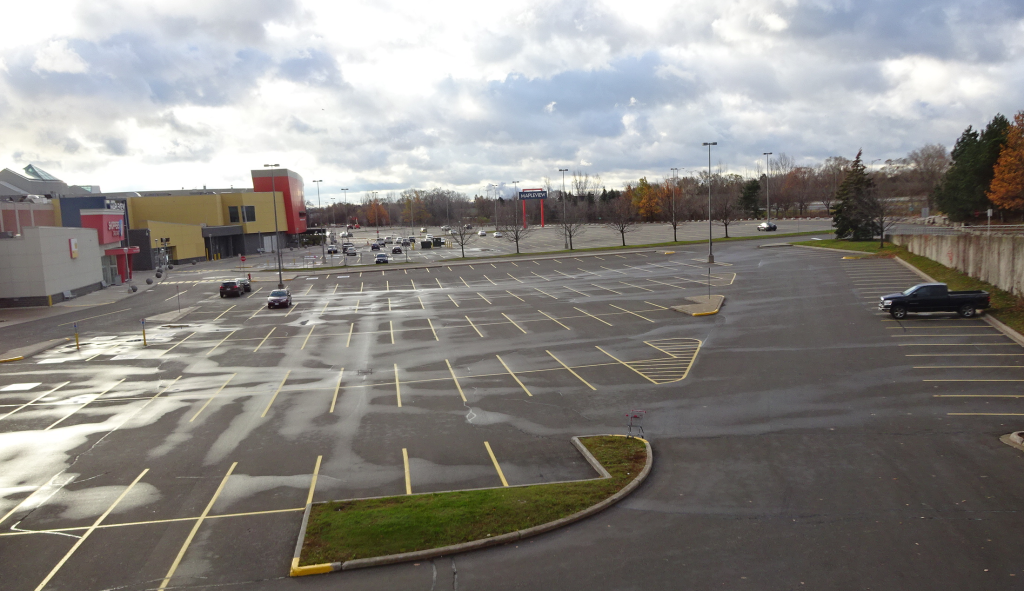 A parking lot today – it was once part of some of the very best farmland in the province from which produce was shipped around the world. Residents of Burlington need not travel far to see the evidence of the Holocene mass extinction event. All of Burlington used to be as richly biologically diverse as the Cootes to the Escarpment EcoPark System. Today in Burlington, most of the Carolinian forests have been cut down and most of the prairies have been paved over. Nearly every tree, shrub, flower and grass in that people in Burlington deliberately cultivate is an alien species. Nearly every ornamental garden in Burlington has at least invasive species that will soon be banned by Ontario’s new invasive species law.
Our urban natural areas are mostly overrun with alien invasive species which have escaped our ornamental gardens and our urban creek floodplains filled with hundreds of tons of trash in the form of tires, couches, car batteries, television monitors, plastic, broken glass… I know because I have literally removed a few tons of trash myself. Our local habitat loss problem is part of the global habitat loss problem and can’t be blamed on anyone else but ourselves.
I wish I could end this story on environmental stories of 2015 on a positive note. But I can’t. We are obviously ruining the planet and most people don’t care. I am certain that in the future, our grandchildren and their grandchildren will look back to this point in time and wonder how we could be so irresponsibly destructive and uncaring about the future of the earth’s biosphere. I wonder too. If anyone is reading this article 100 years from now, I’d like to apologize to you. We could have and should have done much better, but we were too distracted by a few people’s clothing choices and too busy in our daily lives to give the future of the earth any serious thought or consideration.
Sorry.

 By Carol Gottlob By Carol Gottlob
December 27, 2015
BURLINGTON, ON
It was Boxing Day, a day traditionally reserved for ultra-consumerism. Stores were being ransacked for “unbelievable deals”, and mall parking lots were over-flowing. If the retailers didn’t show a profit by this time, we’d likely not see their store fronts next year at Christmas.
I was walking my dog along the Centennial Multi-use Pathway, when I observed a bright coral-coloured mass in the grasses adjacent to the pathway.
 How did these shrimp land on municipal parkland here in Burlington? On closer observation, I came across approximately 20 partially frozen shrimp, the kind you buy ready to serve at supermarkets. There was no packaging. Just dead shrimp. I stood puzzled by this (as was my dog). I took a picture and asked myself, “What is wrong with this picture”? I continued to walk along the path, and on my way back, upon seeing the shrimp still there, I realized, there was so much so very wrong with this.
To begin, the practice of cultivating shrimp in faraway places such as Thailand is ecologically unsound and unsustainable. Furthermore, the labour used to harvest these massive quantities of shrimp is akin to slave labour. Not to mention the toll on the environment by distributing these shrimp all over the world by the plane load, so that they are readily available before their Best Before Date, not only on special occasions, but on any given day of the year.
We don’t necessarily think about it when these delicacies are offered to us at 30% off the regular price, and guests are coming to the house, and we want to make sure we have something to offer them. The holidays bring out all kinds of justification for excessive spending, eating and drinking.
So how did these shrimp land on municipal parkland here in Burlington? My guess is that someone felt bad about simply throwing them in the garbage or the compost, and setting them free in a natural setting somehow made them feel better about it.
Maybe they were sharing Christmas with the creatures of the neighbourhood. Perhaps they simply didn’t like shrimp, or the shrimp had gone bad, and they hoped someone would take pity, rescue them and protect them in a good home. Who knows?
What I do know is that in order to do such a thing, we must be living in a pretty affluent community. Shrimp, even shrimp on sale, is expensive. But to throw them out, uneaten, tells me we are satiated beyond our needs, and can dispose of food we don’t want, without a care.
For whatever reason this came about, the problem then extends even further. Leaving organic matter in parkland attracts urban wildlife (coyotes, racoons, rats). I’ve seen bread, cookies, meat bones and various fruit and vegetables spewn alongside the path at intervals, but never shrimp.
Each time I open the local paper, I read about people feeling uncomfortable, even threatened, having these critters in their neighbourhoods, and beseeching the authorities to remove or cull them. Does this even make sense? “There are too many of them”, they will say.
“Well who invited them?” is the question I would ask.
If we allow ourselves to ignore the excessivness we are responsible for, how are we to establish balance in our existence?
I continued home, my little dog looking back and licking his lips at the thought of what a delightful treat it would have been to savour such tender morsels. Alas.
 Carol Gottlob
Carol Gottlob is a ward 4 resident who ran for municipal office in the last election. She teaches English as a Second Language and walks her dog daily – when she isn’t riding her motorcycle.

By Staff
December 25th, 2015
BURLINGTON, ON
The kids have been up for hours, the gift are unwrapped and you are settling in for a comfortable day or perhaps visiting with family, or food for family that will arrive soon.
 You are enjoying the holiday. You are enjoying the holiday.
Remember, if you will, what we are celebrating – and the why of it all.

 By Ray Rivers By Ray Rivers
December 24, 2015
BURLINGTON, ON
Sorry folks, there’ll be no postcard winter wonderland for us this year. And this is not what we ever meant by the phrase ‘going green’. If there still are climate change doubters/deniers unconvinced by this weather we’re experiencing, the latest scientific research coming out of the Paris climate change conference should give them pause.
 This robin is both cold and confused – for those of us in Burlington we are just confused over the weather we are getting. I saw a robin the other day and our trees are starting to bud – Mother Nature is obviously convinced we are having an early spring. Hey, looks like we missed winter altogether. And I decided to buy new snow tires this year. Hopefully the ranks of climate deniers have crumbled to a few grumpy old men (and women). These are the folks who wish we could go back to the good old days.
But it was how we lived in the good old days that has rewarded us with this new reality. A consequence of global warming is weather volatility, so we may still see snow and cold later this winter, despite the forecasters. I feel sorry for those robins though. Despite the feathers, I’ll bet they’ll feel the chill, when it finally gets cold.
What really is giving me the chills these days is the way every country seems to be beefing up its armaments. It is scary and, though I wasn’t around prior to WWII, it sure looks like history repeating itself. This is not supposed to be happening. Over the last quarter century we’d got used to relative peace, but the doomsday clock now sits at three minutes to midnight. That is only one minute more than it was in 1953, when the US was contemplating nuking China during the Korean war.
It’s Russia and its macho leader, Vladimir Putin, who has challenged the world order and unrepentantly set the planet on this dangerous course. Vlad may seem rational but he is an extreme egotist who openly regrets having seen the demise of the USSR, calling it the worst tragedy of the 20th century. It’s about protecting Russian values from western decadence, and especially the permissiveness of homosexuality, he says, that turns him on it seems.
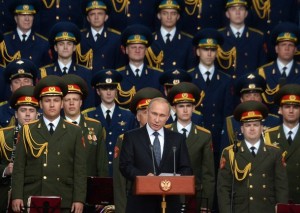 Russian President Vladimir Putin delivers a speech at the opening of the Army-2015 international military forum in Kubinka, outside Moscow. But it’s really about power, as it always has been with old Russia. They have arguably the largest stockpile of nuclear weapons and Putin has no hesitation to remind people that he could use them at will. And indeed he could since, unlike previous Soviet leaders constrained by the communist party, he is a law unto himself with a compliant Duma to rubber stamp his every wish.
And he hasn’t finished with Ukraine yet, having re-supplied his troops there recently and positioned them for a new assault when they think the time is right. But perhaps most worrisome are Putin’s flirtations in Syria, supporting Syria’s ruthless Dictator Assad under the guise of fighting ISIS. His attacks on western supported Syrian rebels contributed to NATO member Turkey’s shooting down one of his war planes. And a hurt and embarrassed Putin is just waiting for an opportunity for revenge.
And that part of the world is getting a lot of air traffic these days. The Brits, French, Americans, Jordanians and Canadians (still) are bombing ISIS in Iraq and Syria. The Russians are hitting the Syrian rebels and the Turks are focusing their bombing for the Kurdish populations in Syria and Turkey. And ironically Turkey’s NATO allies, including Canada, are arming and training the Kurds.
The Iranians and Hezbollah are fighting with Assad’s forces. And Israel, is taking opportunistic shots at Hezbollah leaders when it can. One has to wonder how long will it be before the next incident among all these players brings us to a brink. With only six planes in play, compared to the US with 150, Canada’s contribution to the military conflict is insignificant.
 It was former Prime Minister who convinced the United Nations to create a peacekeeping force that is still in place in some parts of the world. Is the world now beyond peace keeping? Lester Pearson won a nobel prize for his efforts at resolving international conflict. And we could play a much more significant role as honest brokers to help bridge the gap between the parties making war there. Of course we’d have to bring our planes back first. It is hard to negotiate between warring parties when you are one of them.
And it’s not just eastern Europe and the Middle East where military tension is building. Asia has seen a massive buying spree of weapons, including ships, planes, anti-ship and anti-plane systems. Populous India and China are each buying the same sophisticated Russia weapons systems to potentially use against each other. And little Vietnam, with a history of fighting the Chinese, is trying desperately to keep up with them, when those resources could be better spent on economic development and its people.
 The Japanese are now rearming to a level we have no seen since the end of the second world war. These are not cruise ships. Japan, wary of its more assertive neighbour, China, has embarked on a massive re-armament program unseen since the great war. And Germany is considering revising its pacifist constitution. The US and China are playing tag in the South China Sea, along with the Philippines, Vietnam and the Koreas. And speaking of Korea, that Kim clown in the north is doing his best to make Putin look almost reasonable.
I apologize that this is not a very cheery outlook given the time of year and the season of peace we are entering. But ignorance won’t make us any safer. So it’s a big ask. But maybe if we all join our voices this Christmas they’ll get heard. Stop the arms race everywhere. Stop the aggression. Let there be peace. It’s better than the alternative.
 Ray Rivers writes weekly on both federal and provincial politics, applying his more than 25 years as a federal bureaucrat to his thinking. Rivers was a candidate for provincial office in Burlington where he ran as a Liberal against Cam Jackson in 1995, the year Mike Harris and the Common Sense Revolution swept the province. Rivers is no longer active with any political party but he still has a membership card. Ray Rivers writes weekly on both federal and provincial politics, applying his more than 25 years as a federal bureaucrat to his thinking. Rivers was a candidate for provincial office in Burlington where he ran as a Liberal against Cam Jackson in 1995, the year Mike Harris and the Common Sense Revolution swept the province. Rivers is no longer active with any political party but he still has a membership card.
Backgrounds links:
Russian Aggression Putin’s New Year Russian Society Doomsday Clock
Optimistic Public Service
India Arming
What’s with the weather?
How the Russians are arming themselves.

 By Ray Rivers By Ray Rivers
December 18th, 2015
BURLINGTON, ON
There are only a few days left to buy something to put under the tree for my wife. But what I really need is another car. My beloved decade-old Prius has found a new home with my daughter. I bought the car after reading “The Weather Makers” by Australian paleontologist and climate scientist, Tim Flannery. He was so persuasive I even wrote a song about him.
 A Prius – best car Rivers ever bought – he’s in the market for a new one. According to Flannery the single best thing we can do to reduce our carbon footprint is stop driving gas guzzlers. So, I bought a hybrid. And after 200,000 kms at 4.9 l/100 kms (60 mpg), I figure half of my mileage (100,000 kms) was virtually costless and free from emissions, when compared to a conventional auto.
Last week almost 200 national leaders signed up to the Paris (climate) Agreement. But that was the easy part. We’ve been this road before with the Kyoto Protocol, back in 1997, only to find a change in politics killed the deal. Climate deniers GW Bush and our own Stephen Harper did their best to scuttle any attempts at restraining global warming.
And thanks in some small part to them, 2015 will be the warmest year on record. Greenland’s vast glaciers are now melting twice as fast as predicted by climate scientists. And that means that rising sea levels combined with declining polar ice packs will shift the earth’s mass towards the equator slowing down the planet’s rotation and shifting it on its axis – scary stuff.
 Ice fields in Greenland melting faster than anyone predicted – water flows towards the equator impacting the way the earth rotates – and some still don’t see climate change as a problem. Mr. Trudeau has committed to meet with the premiers and come up with a feasible plan of action early in the New Year. A major component of any plan will be a smorgasbord of carrots and sticks to help Canadians get out of old habits. For example, since almost half of all Canadian homes are heated with natural gas, we should expect some financial help with home insulation and alternate heating. And a carbon tax on heating fuels would make sense to help fund these kinds of incentives.
Transportation accounts for about a third of our greenhouse gas emissions and the private motor car makes up about half of that, so expect more incentives to get us onto the new public transportation they keep promising, and into more efficient automobiles. Ontario already offers rebates of up to $8500 for full battery-electric vehicles (BEV) and $5000 for plug-in hybrid vehicles (PHV). But the uptake hasn’t been huge and good luck trying to find them at the car dealer. And even better luck finding a salesperson who knows anything about electric vehicles (EV), PHVs or even hybrids – or understands why you should buy one.
 Get used to see more signs like this – Mayor has one where he normally parks his car. But that’s pretty much it – the rest is stuff we individuals can’t do. The oil sands will require a massive clean-up one way or the other, given where oil prices are going. Some provinces in the prairies and Maritimes will need help converting their electricity generation, as Ontario did recently. Then there is the need for increased reforestation and the development of green technologies.
Fighting wars requires massive amounts of energy and results in all kinds of emission releases, especially when oil-tank cars are being hit by bombs. Yet there has been no discussion of finding better ways to resolve conflicts among nations – especially as the world enters a new era of global tension.
International trade, well that is all about moving goods great distances and burning lots of fuel. It is pure hypocrisy when governments which support more free trade simultaneously sponsor those buy-local campaigns. And speaking of goods transport, trucks now release almost as much greenhouse gas emissions as cars. There was a time when most goods were transported around the country efficiently by rail. Today the rail cars are all busy carrying oil to refineries so it can be burned by the trucks which have now replaced them.
Some folks are saying we need to change the foods we eat as well. According to one researcher lettuce has a greater GHG footprint than pork production. But I don’t believe it. Still other researchers claim that meat production accounts for 15% of all GHG emissions. To that end New Zealand has implemented a cow ‘fart tax’. And beef is the worst of the meats apparently, being labelled the ‘SUV of food’. Which gets us back to motor vehicles.
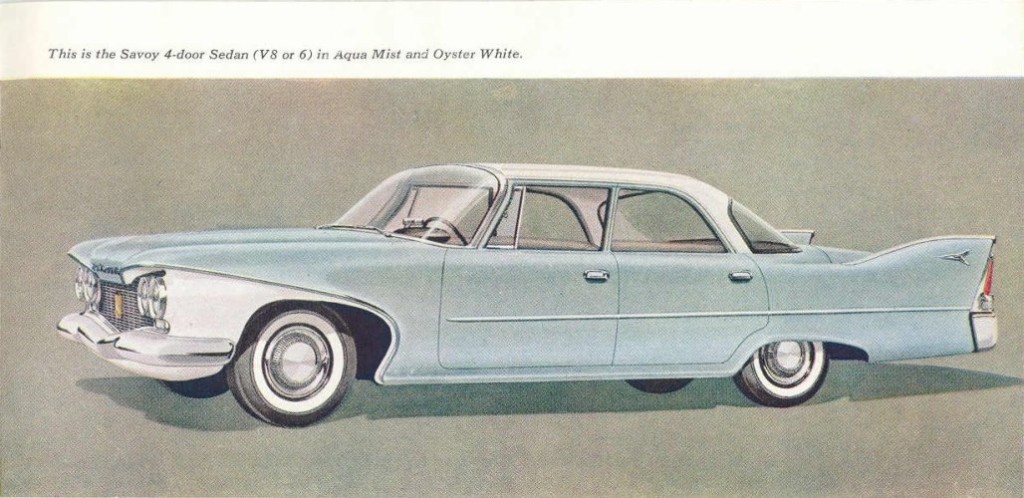 Gas was cheap and the highways were seldom clogged – the drivers felt like Kings – those were the days! I confess that I have always been a car buff. I was just a tadpole when my dad brought home a new Plymouth with those monstrous fins. He wintered his beautiful baby in our barn and I’d occasionally climb in behind the odd-shaped steering wheel and stare at the push button transmission, pretending I was actually driving the big V8 powered behemoth.
My dream car today is the Tesla, named after Nikola Tesla the brilliant Serbian inventor. The car was developed by Elon Musk, a Canadian/American South African guy who invented PayPal and runs Space X as well. A friend of mine has one of these electrically powered beauties and it can go over 300 kms on a charge and move like a cat on catnip. But it costs a bomb and is the only EV with the kind of range I’d be comfortable with, given where I live.
So, unless my publisher pays me a lot more money to write these columns, I’d have to sell my farm and move to the city in order to be able to afford one. But if I did that, one of those more modest EV would do the job – or I could just use environmentally friendly public transportation instead. I hope you’re having better luck with your Christmas shopping than I am.
 Ray Rivers writes weekly on both federal and provincial politics, applying his more than 25 years as a federal bureaucrat to his thinking. Rivers was a candidate for provincial office in Burlington where he ran as a Liberal against Cam Jackson in 1995, the year Mike Harris and the Common Sense Revolution swept the province. Rivers is no longer active politically. Ray Rivers writes weekly on both federal and provincial politics, applying his more than 25 years as a federal bureaucrat to his thinking. Rivers was a candidate for provincial office in Burlington where he ran as a Liberal against Cam Jackson in 1995, the year Mike Harris and the Common Sense Revolution swept the province. Rivers is no longer active politically.
Background links
Cool Video Tim Flannery Flannery Song Paris Agreement
Ignorant Car Dealers Tesla What People Can Do The Hard Work Begins
Earth Slowing Down Electric VehiclesRoad Transport
Trade and Climate Household Energy Use Unattainable
Cow Farts Electric Vehicles EV Rebates
Meat is the New SUV
Car and Truck Emissions Greenland Melting Lettuce Causes Climate Change

|
|





























































































